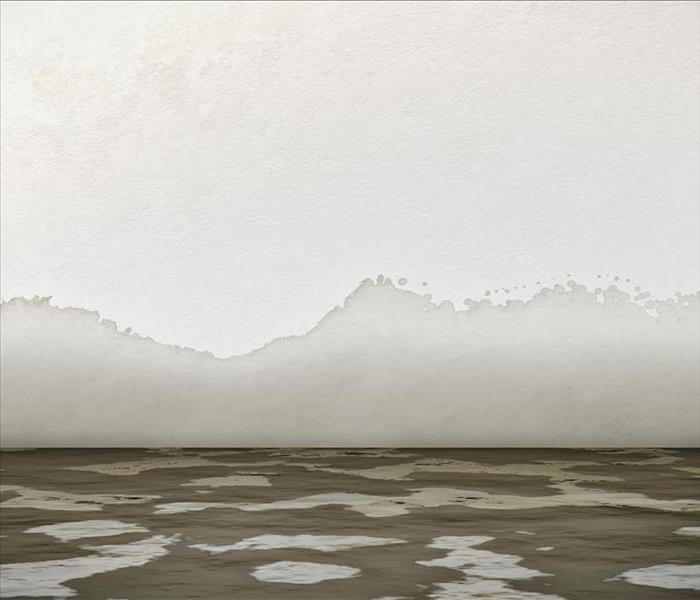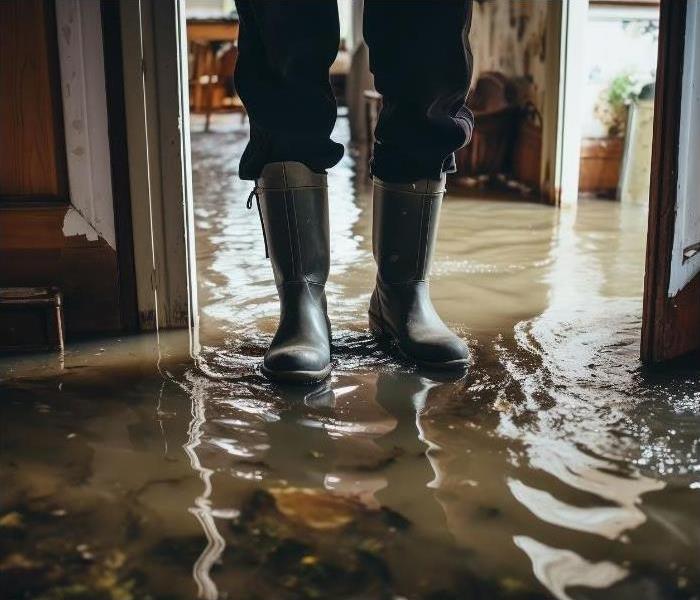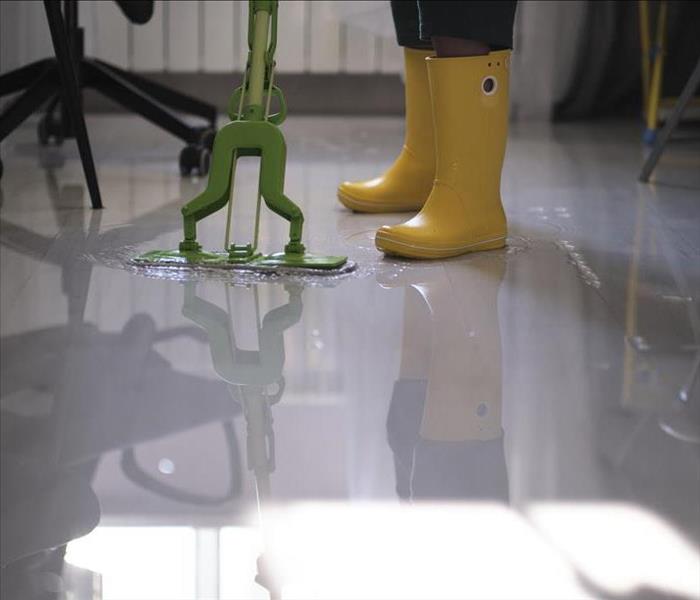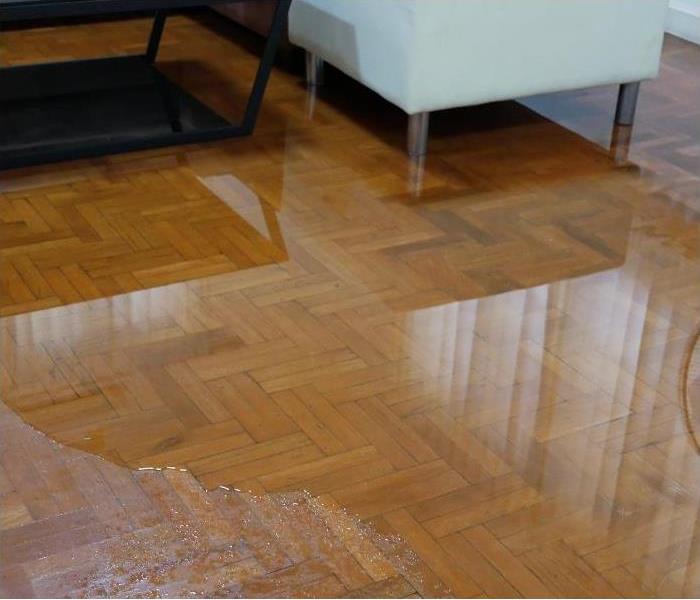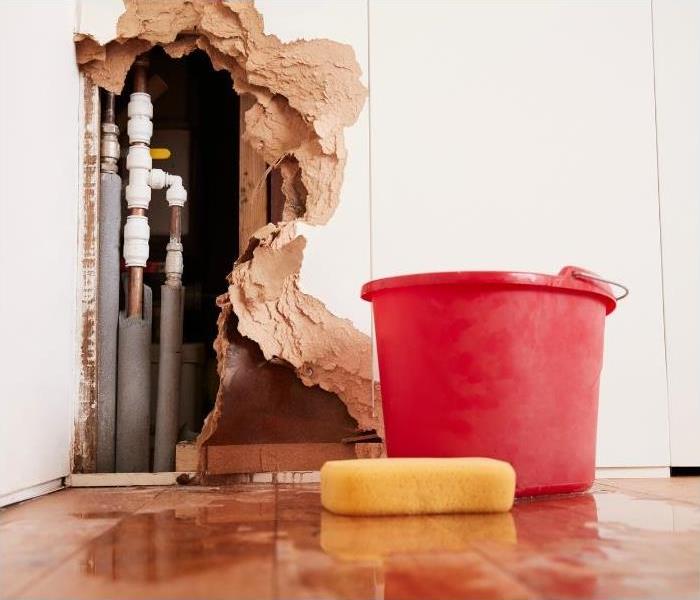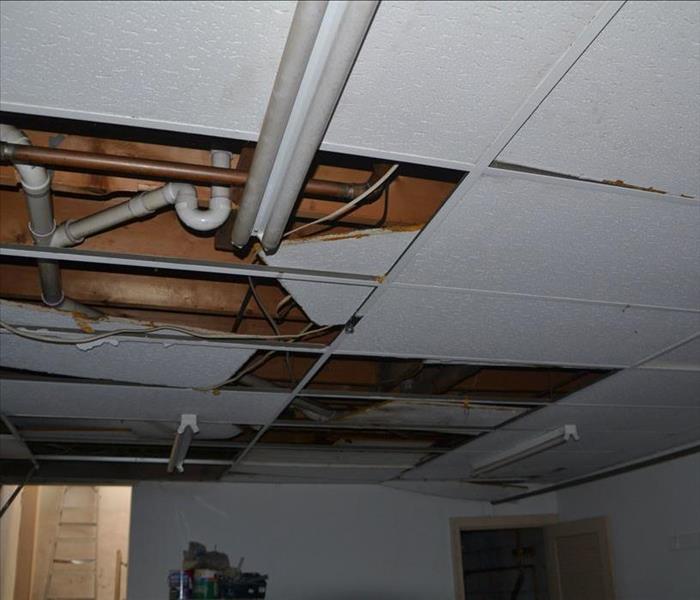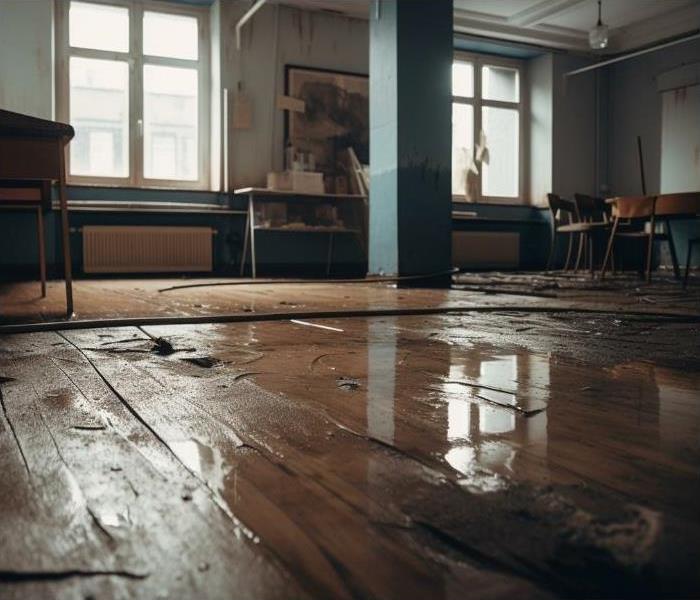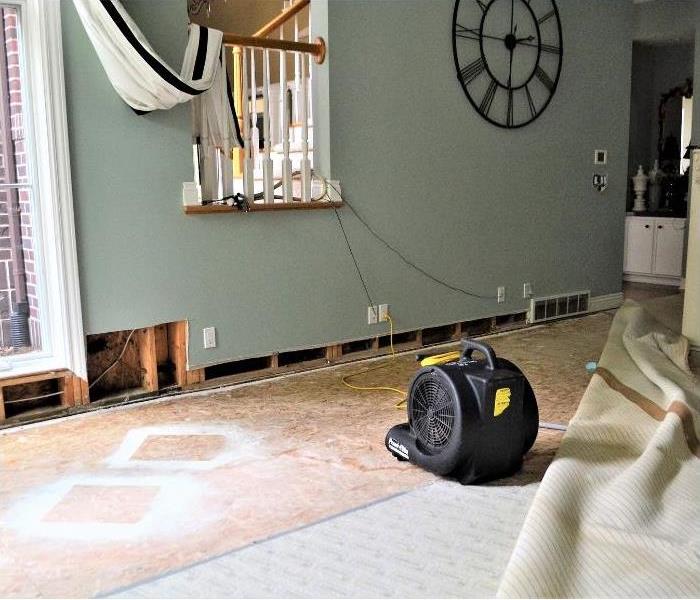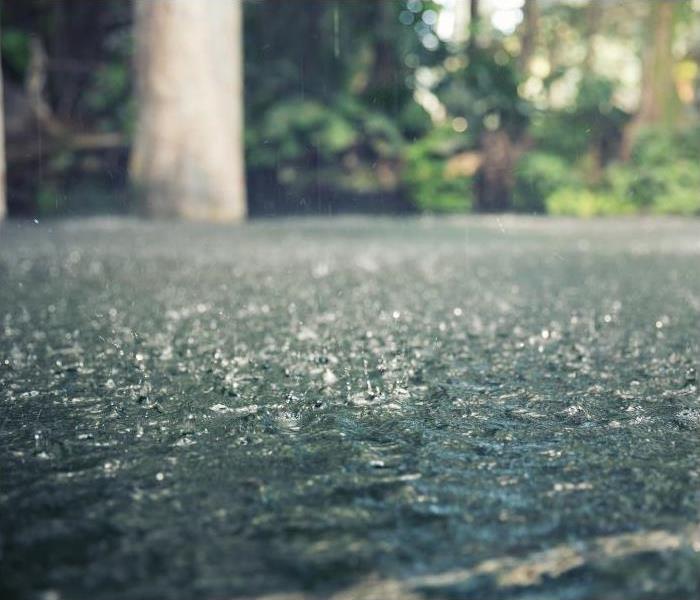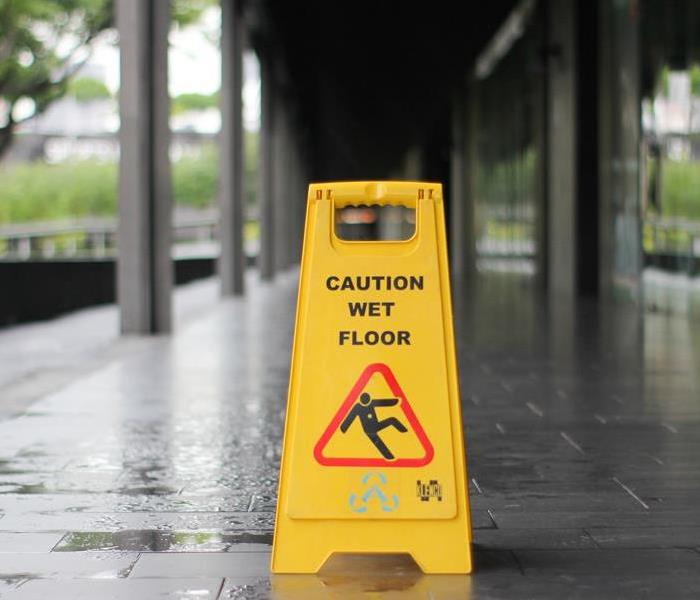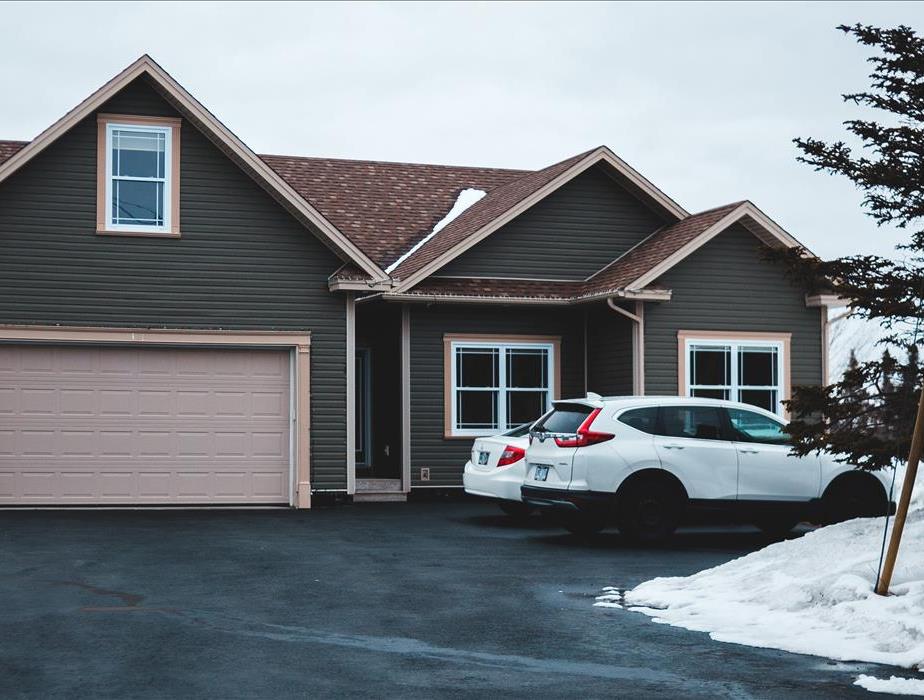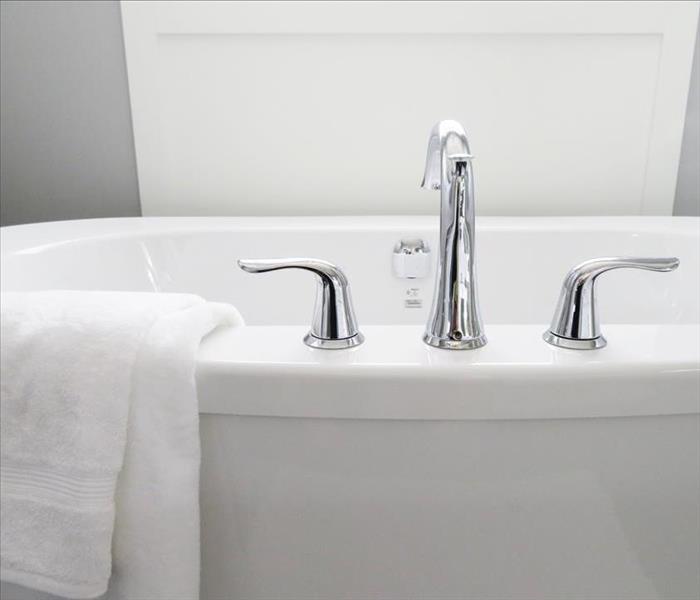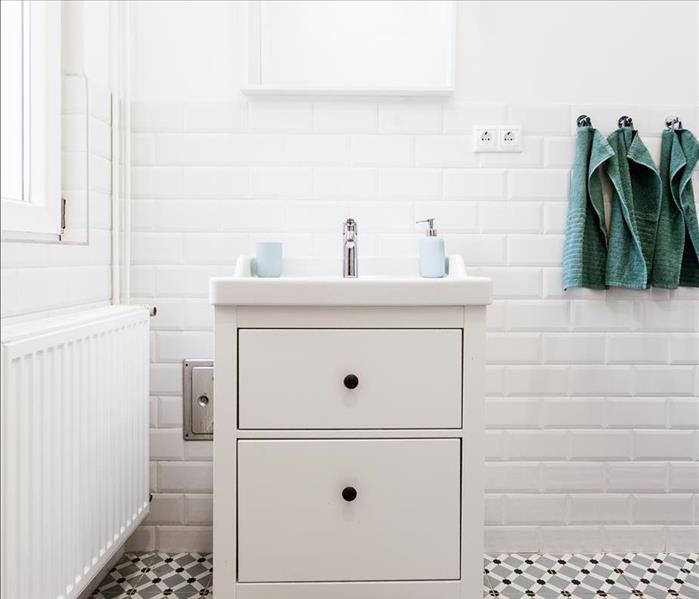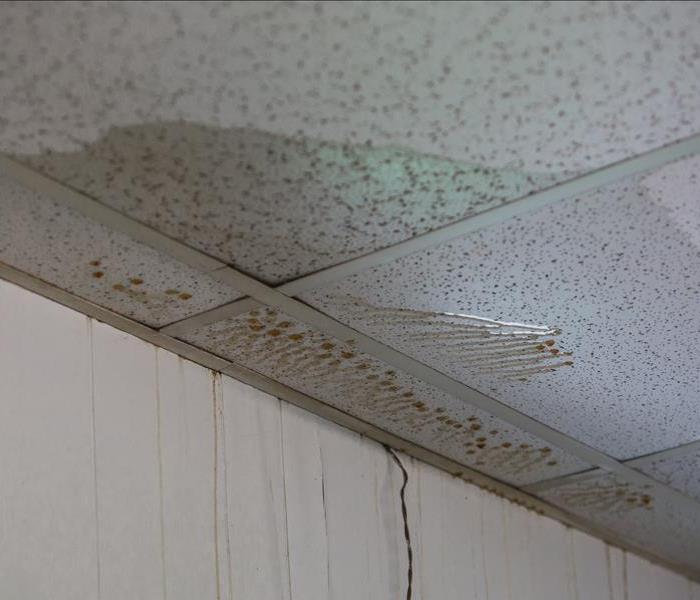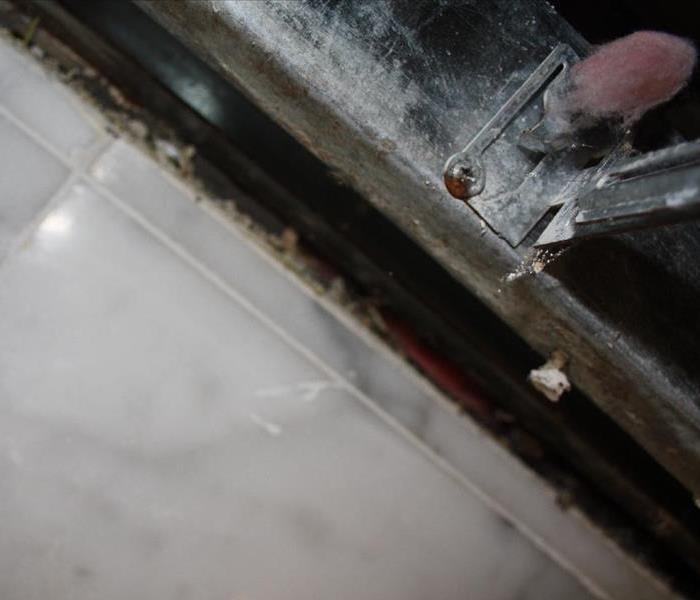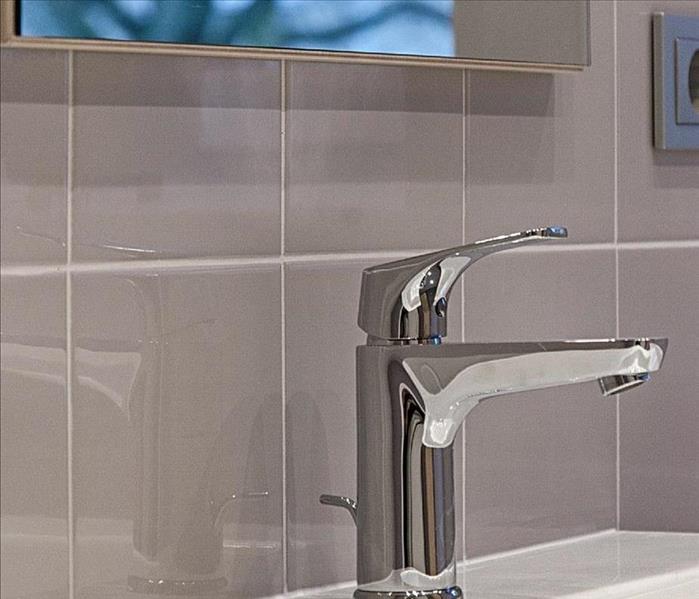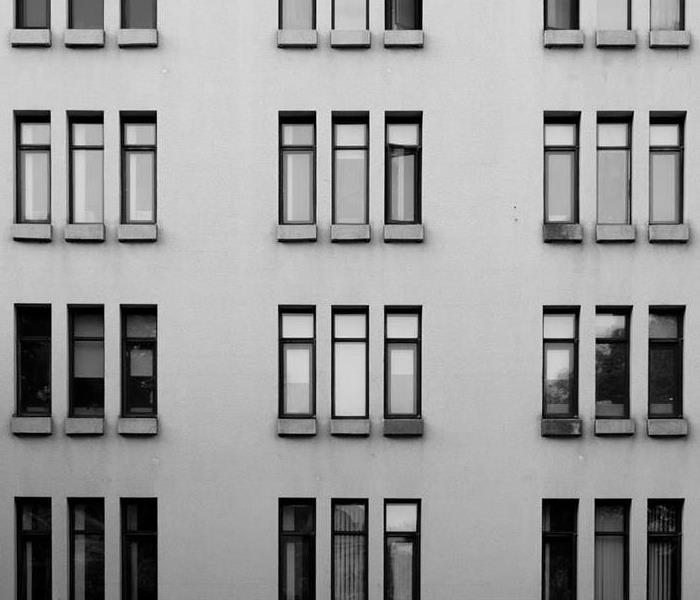Archived Water Damage Blog Posts
Why Choose Us for Water Damage Repair and Construction?
7/9/2024 (Permalink)
When facing water damage, choose us for repair and construction. Our rapid response team acts swiftly to prevent further chaos. Expert assessments guarantee no hidden issues go unnoticed. We offer thorough construction solutions with efficiency in mind. Our advanced technology guarantees high-quality restoration. Our licensed professionals bring years of industry experience. With a proven track record, we deliver excellence every time. Trust us for tailored restoration plans and 24/7 emergency availability. Customer satisfaction is our priority. Discover more about our detailed approach to water damage repair and construction. Your peace of mind is our goal.
Key Takeaways
- Rapid response team for immediate assistance and property protection.
- Expert assessment is needed to determine the extent of damage and create tailored restoration plans.
- Comprehensive construction solutions with efficient processes and sustainable materials.
- Advanced equipment and technology for accurate restoration and reduced disruptions.
- Licensed, insured professionals with a proven track record of successful projects.
Rapid Response Team
When facing water damage, having a rapid response team on standby can make all the difference in minimizing further destruction to your property. In emergency situations, time is of the essence, and quick solutions are paramount to prevent the escalation of damages. Imagine this: a burst pipe flooding your home. The water is seeping into your floors, walls, and furniture, causing chaos and distress. This is where our rapid response team comes into play.
Our experienced team understands the urgency of such situations. Upon receiving your call, we swiftly dispatch our experts to assess the water damage and begin the restoration process immediately. You can rest assured that help is on the way. We prioritize your safety and the protection of your property above all else. From extracting water to drying and dehumidifying the affected areas, our team works efficiently to restore your home to its pre-damaged condition.
Belonging to a community means having support when you need it most. Our rapid response team is here to provide that support and guidance during challenging times. We aim to not only repair the damage but also to ease your worries and uncertainties. With our quick solutions and dedicated team by your side, you can navigate through water damage with confidence and peace of mind.
Expert Water Damage Assessment
Facing water damage can be overwhelming, but with our expert water damage assessment, you can gain valuable insights into the extent of the damage and the necessary steps for restoration. Our skilled technicians are trained to provide a detailed evaluation of the water damage to your property.
When our team arrives at your location, they'll conduct a thorough assessment of the affected areas. This detailed evaluation allows us to understand the full scope of the damage, including any hidden issues that may not be immediately visible. By utilizing advanced equipment and techniques, our technicians can accurately determine the extent of the water damage, providing you with a complete overview of the situation.
Through our expert water damage assessment, you can rest assured that no detail will go unnoticed. Our technicians will document their findings meticulously, ensuring that you have a clear understanding of the damage that has occurred. This transparency is essential in developing a tailored restoration plan that addresses all aspects of the water damage.
With our team of skilled technicians and their commitment to providing a detailed evaluation, you can trust us to guide you through the process of water damage restoration with expertise and care.
Comprehensive Construction Solutions
Our team of construction specialists provides all-encompassing solutions customized to handle all aspects of water damage repair and restoration, guaranteeing a smooth shift from assessment to rebuilding. When it comes to thorough construction solutions, efficiency is crucial. We grasp the urgency in restoring your space, which is why we've refined our processes to be prompt and effective without compromising quality.
Effective processes are at the core of our construction solutions. From planning to execution, every step is carefully streamlined to make sure that your property is restored promptly. Our team is well-versed in managing all the complexities of water damage repair, making the entire reconstruction process seamless and stress-free for you.
Furthermore, we prioritize the use of sustainable materials in our construction projects. We believe in restoring your property in an environmentally conscious manner. By incorporating sustainable materials, we aim to minimize the impact on the environment while still delivering excellent results.
With our team by your side, you can trust that the construction solutions provided will not only meet but exceed your expectations. We're dedicated to creating spaces that you can feel proud of, knowing that every detail has been taken care of with expertise and care.
Advanced Equipment and Technology
Employing state-of-the-art equipment and technology, we enhance the efficiency and precision of our water damage restoration and construction processes to deliver outstanding results. Our dedication to remaining at the forefront of technological advancements guarantees that we provide you with the best solutions for your requirements.
With our cutting-edge tools and innovative solutions, we can swiftly and effectively address water damage issues. Our advanced equipment enables us to detect concealed moisture, evaluate structural damage, and develop a customized plan for restoration. By leveraging the power of technology, we streamline our operations and reduce disruptions to your everyday routine.
The effectiveness of our processes is improved through the incorporation of cutting-edge equipment. From robust water extraction tools to drying machines with accurate control, we've everything necessary to promptly restore your property. Our team is well-versed in maximizing the potential of these tools, ensuring that your water damage repair is carried out with the utmost quality.
Licensed and Insured Professionals
When seeking assistance for water damage repair and construction, making sure that you engage licensed and insured professionals is crucial for a successful and secure restoration process. Choosing certified experts guarantees you a reliable service backed by industry experience.
Licensed professionals have undergone rigorous training and assessments to ensure they meet industry standards, giving you peace of mind that your water damage repair and construction needs are in capable hands. Additionally, working with insured professionals provides an added layer of protection, assuring you that any unforeseen incidents during the restoration process will be covered, minimizing potential risks and liabilities on your end.
By selecting licensed and insured professionals, you're investing in quality workmanship and expertise. Their industry experience equips them with the necessary skills to tackle water damage repair and construction efficiently and effectively. You can trust in their knowledge and capabilities to deliver exceptional results, completing the restoration process to the highest standards.
In times of distress due to water damage, having licensed and insured professionals by your side offers technical proficiency and a sense of security. Their commitment to providing reliable service and their extensive industry experience make them the ideal choice for your water damage repair and construction needs.
Proven Track Record of Success
With a proven track record of success, you can trust in the expertise and reliability of our licensed and insured professionals for your water damage repair and construction needs. Our team prides itself on providing reliable service backed by years of industry experience. When you choose us, you're choosing a company that has consistently delivered high-quality results to countless satisfied customers.
Our track record speaks for itself. We've successfully completed numerous water damage repair and construction projects, earning the trust of our clients through our commitment to excellence. Our experienced professionals understand the complexities of water damage restoration and construction, allowing us to tackle any challenge with confidence and efficiency.
When faced with water damage, you need a team you can rely on. Our proven track record demonstrates our ability to deliver results that exceed expectations. We've honed our skills over years of industry experience, ensuring that we can handle any repair or construction project with precision and care.
Customized Restoration Plans
For your water damage repair and construction needs, we craft personalized restoration plans tailored to address your specific requirements and guarantee a thorough and effective recovery process. When you choose our services, you can trust that we'll work closely with you to develop a plan that fits your unique situation perfectly.
Here's why our customized restoration plans stand out:
- Detailed Assessment: We start by conducting a thorough evaluation of the damage to understand the extent of the issue fully.
- Tailored Solutions: Based on the assessment, we create a personalized approach that addresses your specific needs, ensuring a customized solution for your property.
- Transparent Communication: Throughout the process, we maintain open and clear communication with you, keeping you informed every step of the way.
- Attention to Detail: Our experienced team pays meticulous attention to every aspect, ensuring that nothing is overlooked in the restoration process.
With our personalized approach and customized solutions, we aim to provide you with a sense of security and belonging during a challenging time. Your satisfaction and peace of mind are our top priorities, and we're dedicated to delivering exceptional results that exceed your expectations. Trust us to handle your water damage repair and construction needs with care and expertise.
24/7 Emergency Availability
In times of urgent need, our team remains available around the clock to swiftly respond to your emergency water damage situations. We comprehend the distress that water damage can bring, and that's why our 24/7 availability is here to offer you the quick response you need during such challenging times.
When faced with water damage, every minute counts. That's why our dedicated team is always on standby, ready to jump into action at any hour of the day or night. Whether it's a burst pipe in the middle of the night or a flooded basement over the weekend, you can rely on us to be there promptly to assess the situation and start the restoration process.
Our experienced technicians are trained to handle emergency water damage situations with efficiency and care. From extracting water and drying out the affected areas to preventing mold growth, we make certain that every step is taken to mitigate the damage and restore your property to its preloss condition.
Don't hesitate to reach out to us the moment water damage strikes. Our commitment to providing timely and effective solutions is unwavering, giving you peace of mind knowing that help is just a phone call away. Trust us to be your reliable partner in restoring your home from water damage, no matter the time of day.
Customer Satisfaction Guarantee
Rest assured, your satisfaction is our highest priority when it comes to our water damage repair and construction services. We acknowledge the stress and disruption that water damage can bring to your life, and we're dedicated to guaranteeing that the repair and construction process is as smooth and satisfying as possible for you.
Here's why you can trust us to guarantee your satisfaction:
- Quality Craftsmanship: Our team of skilled professionals takes pride in delivering exceptional craftsmanship on every project. From repairing water-damaged structures to constructing new elements, we pay attention to every detail to guarantee the highest quality results.
- Timely Completion: We acknowledge the importance of completing the work promptly to minimize inconvenience to you. Our efficient processes and dedicated team allow us to meet deadlines and deliver results in a timely manner.
- Transparent Communication: We believe in clear communication throughout the project. You'll be kept informed of progress, any challenges encountered, and any necessary adjustments to the plan. Your input is valuable to us.
- Follow-Up Assistance: Our commitment to your satisfaction doesn't end when the project is completed. We provide follow-up assistance to address any questions or concerns you may have after the repair and construction work is done. Your peace of mind is important to us.
Review
When it comes to water damage repair and construction, choosing us means you're in good hands. Our rapid response team, expert assessment, thorough solutions, advanced technology, licensed professionals, and proven track record guarantee excellent service.
With tailored restoration plans, 24/7 availability, and a satisfaction guarantee, we prioritize your needs and deliver results. Trust us to restore your property with care and expertise.
7 Essential Tips for Emergency Water Damage Repair
5/28/2024 (Permalink)
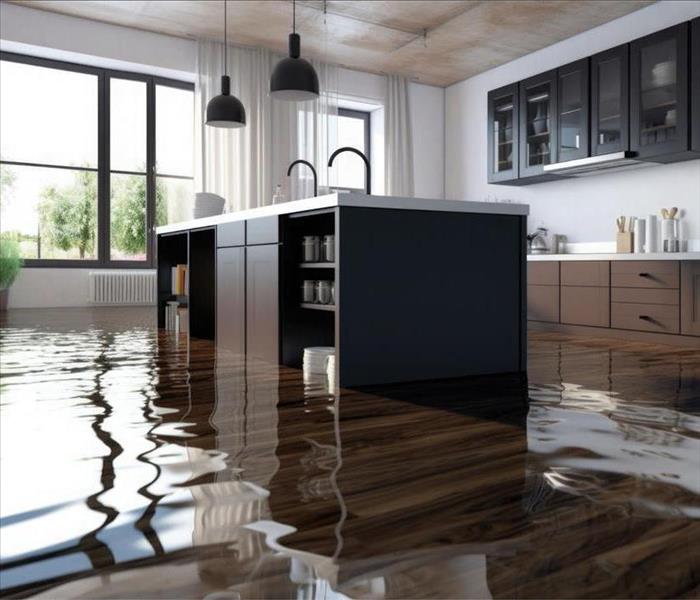 A kitchen with standing water on the floors.
A kitchen with standing water on the floors.
When facing emergency water damage repair, here are the seven essential tips: Assess all affected areas thoroughly. Stop the water source promptly to prevent more damage. Remove standing water within 48 hours to avoid mold growth. Dry out affected areas completely with proper ventilation. Salvage valuable items carefully to prevent further damage. Prevent mold growth by thorough drying and cleaning. Consider hiring professional restoration services for expert assistance. Following these steps can help you save time and costs and ensure a successful restoration process. Each tip is vital for effective recovery and protection of your property.
Key Takeaways
- Assess the extent of water damage promptly.
- Extract standing water within 48 hours to prevent mold.
- Dry affected areas thoroughly to avoid structural issues.
- Salvage valuables using proper drying techniques.
- Prioritize professional restoration services for efficient repair.
Assessing the Damage
When examining the damage from water emergencies, carefully inspect all affected areas for signs of water infiltration. Evaluating the importance of the damage is essential to determine the necessary steps for restoration. Check walls, ceilings, and floors for any visible water stains, discoloration, or warping. Pay close attention to areas where water will likely accumulate, such as basements, bathrooms, and around appliances like water heaters or dishwashers. Look for any soft spots on walls or ceilings, as these could indicate water saturation.
Prioritizing safety is paramount during the assessment process. Before entering any water-damaged areas, ensure the electricity is turned off to prevent the risk of electrical shocks. Wear protective gear such as gloves, rubber boots, and a mask to avoid contact with contaminated water or mold. Be cautious when moving around the affected areas, as wet surfaces can be slippery and pose a falling hazard.
Note any furniture, belongings, or structural elements affected by the water damage. Document the damage with photographs or videos for insurance purposes. Assess the condition of carpets, insulation, and drywall to determine what can be salvaged and what needs to be replaced. By thoroughly evaluating the importance of the water damage and prioritizing safety, you can effectively plan the next steps for restoration.
Stopping the Water Source
To effectively mitigate water damage, promptly halt the source of water infiltration to prevent further escalation of the emergency. The first step is to identify leaks in your home. Check common areas such as under sinks, around water heaters, and near appliances like dishwashers and washing machines. Look for water stains, mold growth, or any unusual dampness that could indicate a leak. Pay close attention to areas with visible pipes or where water is regularly used.
Once you've identified a leak, the next vital step is to shut off the water source. Locate your main water shut-off valve; this is usually found near the water meter where the main water line enters your home. Turn the valve clockwise to close it and stop the flow of water into your house. In case of localized leaks, like under a sink or behind an appliance, there are usually individual shut-off valves that you can use to stop the water supply to that specific area.
Removing Standing Water
Begin by using a wet vacuum or pump to extract the standing water from the affected area efficiently. This initial step is important in preventing further damage and mold growth. Water extraction should be done promptly to minimize the risk of structural issues and health hazards.
Here are some essential tips to guide you through the process:
- Move Quickly: Act fast to remove standing water within the first 48 hours to prevent mold growth and additional damage.
- Focus on Hidden Areas: Ensure thorough water extraction from hidden spots like under furniture, carpets, and within wall cavities to prevent moisture pockets.
- Monitor Humidity Levels: Use dehumidifiers to maintain ideal humidity levels below 60% to discourage mold growth.
Effective water extraction is crucial in mitigating the impact of water damage. By promptly removing standing water, you can prevent mold proliferation and structural deterioration. Remember to be thorough in your extraction efforts, paying attention to both visible and concealed areas where water might accumulate. Stay vigilant in monitoring humidity levels post-extraction to create an environment inhospitable to mold.
Drying Out Affected Areas
Maximize air circulation in the affected areas to expedite the drying process efficiently and effectively. Proper airflow is vital for drying out water-damaged spaces. Make sure windows and doors are open to promote ventilation. Position fans strategically to create cross-ventilation, aiding in the evaporation of moisture. Place dehumidifiers in key locations to extract excess moisture from the air, accelerating the drying process greatly.
Utilize a wet/dry vacuum to remove any remaining water that may be trapped in carpets, rugs, or upholstery. These versatile tools can help extract water efficiently, preventing further damage and mold growth. Remember to empty the vacuum regularly to maintain its effectiveness.
For areas that are damp but not saturated, use absorbent towels to soak up excess moisture. Press the towels firmly against the wet surface to absorb as much water as possible. Replace the towels as needed to continue drawing out moisture until the area is dry.
Salvaging Belongings
Open windows and doors to facilitate ventilation and create a conducive environment for salvaging belongings affected by water damage. Salvaging valuables after a water-related disaster is essential to minimize losses and preserve items with sentimental or monetary value.
Here are some essential steps to help you salvage your belongings effectively:
- Prioritize Items: Begin by salvaging items that are most valuable or have significant sentimental value. This may include important documents, photographs, jewelry, and electronics.
- Documenting Losses: Keep a detailed inventory of the items that have been damaged by water. Take photographs or videos of the affected belongings as part of the documentation process. This will be helpful for insurance claims and assessment of the overall damage.
- Proper Drying Techniques: Ensure that salvaged items are dried properly to prevent further damage and mold growth. Use dehumidifiers, fans, and air dryers to expedite the drying process. Avoid using heat sources that may cause damage to delicate items.
Preventing Mold Growth
To prevent mold growth after water damage, promptly initiate thorough drying procedures on all affected surfaces and items. Mold prevention is essential in ensuring the safety of your home and belongings. Begin by opening windows and using fans to increase air circulation. Dehumidifiers are also effective in removing excess moisture from the air. Focus on drying out carpets, furniture, and walls as they're prone to mold growth in damp conditions.
Moisture control is key in preventing mold from spreading. Check hidden areas like behind walls and under flooring for any trapped moisture. Use towels and mops to soak up standing water, and consider removing baseboards to allow for better airflow. Inspect for any leaks in plumbing or roofing that could be the source of moisture accumulation.
Remember to clean and disinfect all surfaces after drying to prevent mold spores from taking hold. A solution of water and detergent can help remove dirt and grime that mold feeds on. For porous materials like wood or drywall that may have absorbed water, it's best to consult with professionals on whether they can be salvaged or need replacement.
Hiring Professional Restoration Services
Consider reaching out to professional restoration services for effective and thorough water damage repair. When faced with water damage in your home, hiring experts can make a significant difference in the restoration process. Here are some reasons why opting for professional services is the best choice:
- Expertise and Experience: Professional restoration services have the knowledge and experience to assess the extent of the water damage accurately. They can provide a detailed plan to restore your property efficiently, minimizing further damage.
- Specialized Equipment: Restoration companies use specialized tools to extract water, dry affected areas, and restore your home to its pre-damaged condition. These devices are essential for thorough water damage repair and aren't typically available for DIY use.
- Insurance Assistance: Many professional restoration companies work directly with insurance providers, simplifying the claims process for you. They can help document the damage, provide necessary evidence for your claim, and ensure that you receive fair coverage according to your policy.
While there are DIY options for water damage repair, the expertise, equipment, and insurance assistance provided by professional restoration services can streamline the process and guarantee a successful restoration of your home. When dealing with water damage, entrusting the job to trained professionals can save you time, effort, and potentially reduce overall costs in the long run.
Recap
Heeding these crucial tips for emergency water damage repair can help minimize the damage to your property and belongings.
By promptly evaluating the damage, halting the water source, eliminating standing water, drying out impacted areas, salvaging belongings, preventing mold growth, and enlisting professional restoration services, you can effectively address the situation and restore your home back to its original condition.
Remember, acting swiftly and methodically is key in handling water damage emergencies.
The Essential Checklist for Post-Flood Recovery
3/4/2024 (Permalink)
When life throws you a curveball and floods come crashing into your world, it can feel like the calm after the storm is just as chaotic. But fear not, for amidst the wreckage lies a roadmap to recovery, a checklist that will help you navigate the muddy waters of post-flood restoration.
From assessing the damage to salvaging your precious belongings, from drying and cleaning the affected area to documenting the restoration process, each step is crucial.
So, grab a pen and paper, for we are about to embark on a journey that will lead you from the depths of despair to the shores of recovery.
Assessing the Damage
Assess the extent of the damage caused by the flood by thoroughly inspecting your property. After a devastating flood, it's crucial to evaluate the damage to determine the next steps in your recovery process. Begin by carefully examining each area of your property, paying close attention to walls, floors, and furniture. Take photographs or videos to document the destruction, as this evidence will be essential for filing insurance claims. Remember, you aren't alone in this journey. Many others have faced similar challenges and have successfully navigated through the recovery process.
When assessing the damage, be on the lookout for signs of mold growth. Floodwaters create a breeding ground for mold, which can be hazardous to your health. Mold can cause respiratory problems, allergies, and other health issues. To prevent the growth of mold, remove any wet or damp materials immediately. Dry out the affected areas as soon as possible using fans, dehumidifiers, and open windows. Thoroughly clean and disinfect all surfaces, including furniture and personal belongings. It may be necessary to consult with professionals who specialize in mold remediation to ensure a thorough and safe cleanup.
In addition to documenting the damage and taking measures to prevent mold growth, it's vital to contact your insurance company promptly. Notify them about the flood and initiate the claims process. Provide them with the necessary evidence, such as photographs, videos, and a detailed inventory of the damaged items. Keep records of all communication with your insurance company, including names, dates, and any agreements made. This documentation will help expedite the claims process and ensure a fair resolution.
Contacting Professionals
To ensure a thorough and safe cleanup, it's essential to reach out to professionals who specialize in mold remediation. Mold can quickly spread and cause health hazards if not properly addressed. By contacting experts, you can rely on their knowledge and experience to handle the situation effectively.
Here are some key reasons why reaching out to professionals is crucial:
- Expertise and Experience: Mold remediation professionals have the necessary skills and expertise to assess the extent of the damage accurately. They know how to identify hidden mold growth and develop a comprehensive plan to eliminate it. Their experience allows them to handle the process efficiently, minimizing any further damage to your property.
- Finding Resources: Professionals have access to specialized tools and equipment that are needed for effective mold remediation. They can also recommend trusted contractors for repairs and restoration, ensuring that your property is restored to its pre-flood condition. By utilizing their resources, you can save time and effort in finding and coordinating with different service providers.
- Insurance Coverage: Mold remediation can be costly, but many homeowners' insurance policies cover such damages. Professionals can help guide you through the insurance claims process, ensuring that you receive the maximum coverage you're entitled to. They can provide documentation and evidence required by your insurance company, making the entire process smoother and less overwhelming.
Salvaging Belongings
Now that you have reached out to professionals for mold remediation, it's time to focus on salvaging your belongings after the flood. It's understandable that you might feel overwhelmed, but with the right salvage techniques, you can restore your belongings and bring a sense of normalcy back to your life.
When it comes to restoring belongings, the first step is to prioritize. Start with the items that hold the most sentimental value or are essential for your daily life. These could be family heirlooms, photographs, or important documents. Use caution when handling wet items, as they can easily tear or become damaged. Gently remove excess water and lay them out to dry in a well-ventilated area. Avoid direct sunlight, as it can cause further damage.
For furniture and larger items, it's best to consult a professional restoration service. They have the expertise and equipment to properly clean and dry these items to prevent mold growth and further deterioration. Remember to document any damages for insurance purposes.
Clothing and textiles can be salvaged through washing and disinfecting. Use a mild detergent and hot water to remove dirt and bacteria. Air-dry them outside or use a dryer on a low heat setting. Consider discarding items that are heavily soiled or have been in contact with sewage.
Electronics and appliances should be inspected by a professional before attempting to salvage them. Water damage can cause irreparable harm, so it's crucial to have them thoroughly assessed.
Drying and Cleaning the Affected Area
To effectively restore your home after a flood, it's crucial to thoroughly dry and clean the affected area. This step is essential to prevent further damage and ensure a safe living environment. Here are three important tasks you should focus on when drying and cleaning the affected area:
- Remove standing water: Start by removing any standing water in your home. Use pumps, wet vacuums, or buckets to extract the water. Make sure to wear protective gear such as rubber boots and gloves to avoid contact with contaminated water. Dispose of the water properly to prevent it from re-entering your home.
- Dry out the area: Once the standing water is removed, it's important to thoroughly dry out the affected area. Open windows and doors to promote air circulation. Use fans and dehumidifiers to accelerate the drying process. Remove any wet materials, such as carpets, furniture, and drywall, that can't be salvaged. This will help prevent mold growth and further damage to your home.
- Clean and disinfect: After the area is dry, it's time to clean and disinfect. Use a mild detergent and warm water to clean all surfaces. Pay special attention to areas that were directly affected by the floodwater. Use a bleach solution to disinfect and kill any remaining bacteria or mold spores. Make sure to wear protective clothing and ventilate the area properly while cleaning.
During the drying and cleaning process, it's important to keep in mind the need for mold prevention and structural repairs. Mold can grow rapidly in damp environments, so it's crucial to address any signs of mold growth immediately. Additionally, assess the structural integrity of your home and make necessary repairs to prevent further damage.
Documenting the Restoration Process
Start by taking detailed photographs and videos of the restoration process to document the progress and any damages that need to be addressed. This step is crucial for insurance claims and assessing the long-term effects of the flood. By documenting the restoration process, you can provide evidence of the work that has been done and the challenges that have been faced.
When taking photographs, make sure to capture the affected areas from different angles. Focus on any visible damages, such as structural issues, water damage, or mold growth. Take close-up shots to highlight specific details and wider shots to provide an overall view of the restoration site. Additionally, record videos to capture the restoration process in action. This can include footage of the cleaning and drying process, the repair work being done, and any necessary replacements or installations.
Ensure that the photographs and videos are clear and well-lit so they can be easily understood and analyzed later on. Label each file with a descriptive name and organize them in a systematic manner. This will make it easier to locate specific images when needed.
Remember to document any changes or improvements that are made throughout the restoration process. This will help demonstrate the progress being made and provide a timeline of events. It's also important to note any challenges or setbacks encountered, as these may have an impact on insurance claims or future repairs.
Review
Recovering from a flood requires a systematic approach.
Assess the damage, contact professionals, salvage belongings, dry and clean the affected area, and document the restoration process.
For example, imagine a family whose basement was flooded. They quickly contacted a professional restoration company that assessed the damage, salvaged their valuable possessions, thoroughly cleaned and dried the area and documented the entire process for insurance purposes.
With a checklist like this, flood recovery can be more manageable and efficient.
Seasonal Safety: Winterizing Your Home to Prevent Water Damage
1/8/2024 (Permalink)
Are you ready for winter?
Protecting your home from potential water damage is important as the temperature drops and snow starts to fall. You may not realize it, but your home is vulnerable to leaks and floods during this time of year.
But fear not because there are simple steps you can take to winterize your home and keep it safe and dry.
So, let's dive into seasonal safety and discover how to safeguard your home from water damage this winter.
Insulating Pipes
To prevent pipes from freezing and potentially bursting, you need to insulate them using foam or pipe sleeves. Preventing freezing is crucial to avoid costly repairs and water damage to your home. The good news is that various pipe insulation options are available to you.
Foam insulation is a popular choice for insulating pipes. It's easy to install and provides excellent protection against freezing temperatures. You can find foam insulation in the form of tubes or self-adhesive strips. Simply wrap the foam around the pipes, ensuring a snug fit, and secure it with tape. Foam insulation is affordable and readily available at most hardware stores.
Another option is pipe sleeves, which are specifically designed to insulate pipes. These sleeves are made of rubber or fiberglass and provide effective insulation against freezing. Pipe sleeves come in different sizes and can be easily cut to fit your pipes. They're also simple to install, usually requiring only adhesive or zip ties to hold them in place.
When insulating your pipes, covering all exposed areas, including those in unheated spaces like basements, crawl spaces, and attics, is essential. Pay close attention to pipes near exterior walls or areas with minimal insulation.
Sealing Gaps and Cracks
Now that you have insulated your pipes, it's time to address another important aspect of winterizing your home: sealing gaps and cracks.
Weather stripping and caulking prevent cold air from seeping into your cozy abode. By sealing these gaps, you keep the cold air out and ensure that warm air stays inside, saving you on heating costs and creating a more comfortable living environment.
One of the areas where gaps and cracks often occur is around windows and doors. Weatherstripping is a simple yet effective solution to seal these openings. It involves applying a strip of material, such as foam or rubber, along the edges of windows and doors. This creates an airtight seal, preventing drafts and reducing heat loss. Weatherstripping is easy to install and can be found at your local hardware store.
Caulking is another technique that helps seal gaps and cracks in your home. It involves using a waterproof sealant to fill in cracks around windows, doors, and other areas where air may enter. Caulking not only keeps the cold air out but also prevents water from seeping in, which can lead to water damage and mold growth. Make sure to choose a high-quality caulk suitable for your specific needs, such as silicone-based caulk for areas exposed to moisture.
When applying weather stripping and caulking, properly preparing the surfaces is important. Clean the areas thoroughly and remove any old caulk or peeling paint. Apply the weather stripping or caulk in a continuous, even line, filling in all gaps and cracks. For a neat finish, smooth the surface with your finger or a caulking tool.
Clearing Gutters and Downspouts
Start by inspecting your gutters and downspouts for any debris or blockages. Clearing your gutters and downspouts is essential in winterizing your home to prevent water damage. Neglecting this task can lead to clogged gutters, which can cause water to overflow and damage your roof, walls, and foundation.
To ensure your gutters and downspouts are clear and functioning properly, follow these steps:
- Remove leaves and debris: Use a sturdy ladder to reach your gutters and remove any leaves, twigs, or other debris that may have accumulated. You can use a small trowel or scoop to make the job easier.
- Check for blockages: Look for any blockages in your gutters and downspouts. Pay special attention to areas where the downspouts connect to the gutters. Use a garden hose to flush out debris or a plumber's snake to clear any stubborn clogs.
- Inspect for damage: While you're clearing the gutters, take the opportunity to inspect them for any signs of damage. Look for loose or sagging gutters and any cracks or holes. Repair or replace any damaged sections to ensure proper water flow.
- Consider gutter guards: Installing gutter guards can help prevent debris from accumulating in your gutters, reducing the need for frequent cleaning. They can also help prevent ice dams from forming, which can cause water to back up and seep into your home.
Protecting Outdoor Faucets
Inspecting and protecting your outdoor faucets is another crucial step in winterizing your home to prevent water damage. Taking the necessary precautions to ensure your faucets are ready for the colder months ahead is important.
One of the first things you should do is disconnect and winterize any hoses connected to your outdoor faucets. This will help prevent any water from freezing inside the hoses and potentially causing damage to your faucets.
Once you have disconnected your hoses, covering your outdoor faucets is a good idea. You can easily find faucet covers at your local hardware store or online. These covers are designed to insulate and protect your faucets from freezing temperatures. They're usually made of foam or insulation material and can easily be installed over your faucets. Make sure to secure them tightly to ensure a snug fit.
Covering your outdoor faucets won't only prevent freezing but also help protect them from any debris or ice that may accumulate during the winter. This extra layer of protection will go a long way in preventing any potential damage and costly repairs.
Checking and Maintaining Your Sump Pump
To ensure the proper functioning of your sump pump during the winter months, it's crucial to check and maintain it regularly. Taking the time to maintain your sump pump can save you from potential water damage and costly repairs. Here are some important steps to keep in mind:
- Inspect the sump pump: Regularly check the sump pump for any signs of damage or wear. Look for cracks in the pump housing, loose or damaged wires, or any debris blocking the pump.
- Test the sump pump: To ensure that your sump pump is working properly, test it by pouring a bucket of water into the sump pit. The pump should automatically turn on and drain the water. If it doesn't, there may be a problem with the float switch or the motor.
- Clean the sump pit: Over time, debris and sediment can accumulate in the sump pit, affecting the pump's performance. Regularly clean the sump pit to remove any dirt, rocks, or other debris that may be present.
- Check the discharge pipe: Make sure the discharge pipe is free from any obstructions and is properly attached to the pump. A clogged or disconnected discharge pipe can prevent the water from being pumped out effectively.
Summary
Winterizing your home is like wrapping it in a warm embrace, shielding it from the icy grip of water damage.
By insulating pipes, sealing gaps, clearing gutters, protecting outdoor faucets, and checking your sump pump, you're ensuring a safe haven for your home.
So, don't let winter's cold touch leave your home vulnerable – take the necessary steps to keep it snug and secure.
Water Damage Restoration: How to Recover From a Flood
12/5/2023 (Permalink)
Are you facing the aftermath of a flood? Don't worry - you can recover! Learn how to restore your home and belongings after water damage with the help of SERVPRO South and Northwest Grand Rapids.
We specialize in professional water extraction, drying, and restoration services. This article will guide you through the steps to assess the damage and take immediate action.
Don't let a flood keep you down - let SERVPRO help you get back to feeling at home.
Key Takeaways
- Inspect your home's affected areas thoroughly and assess the damage.
- Contact your insurance company and report the incident.
- Reach out to SERVPRO South and Northwest Grand Rapids for professional cleaning and restoration services.
- SERVPRO specializes in water extraction, drying, mold remediation, odor removal, and home renovation, ensuring timely and comprehensive restoration.
Assessing the Damage
To assess the damage to your property after a flood, you should thoroughly examine your home's affected areas. This is crucial in determining the extent of the damage and documenting it for insurance coverage.
Begin by inspecting the exterior of your home and checking for any visible signs of damage, such as cracks in the foundation, water stains, or warped siding. Take note of any debris or mud that may have accumulated, as this can indicate the level of water intrusion.
Next, move indoors and carefully assess each room. Look for signs of water damage, such as wet or discolored walls, ceiling stains, or a musty odor. Pay close attention to the flooring, checking for any warping, buckling, or delamination. Inspect electrical outlets, switches, and appliances for signs of water exposure, as this can pose a significant safety risk.
When assessing the extent of the damage, it's important to take detailed photographs and list all affected items. This documentation will be essential when filing an insurance claim. Contact your insurance provider as soon as possible to report the damage and ensure you understand the coverage and claims process.
Immediate Steps to Take
Start by contacting SERVPRO South and Northwest Grand Rapids for immediate assistance with water damage restoration. When faced with a flood, taking immediate action is crucial to minimize further damage and ensure a swift recovery. Here are the immediate steps you should take to begin the cleaning process and streamline your insurance claims.
First and foremost, ensure your safety by turning off all electrical sources in the affected areas. Water and electricity are a dangerous combination, so it's essential to prioritize your well-being. Once you've secured your safety, remove any valuable items or furniture from the affected area to prevent further damage. Be cautious while doing this, and wear protective gear like gloves and boots to avoid any potential harm.
Next, take photos or videos of the damage for documentation purposes. This evidence will be valuable when filing your insurance claims. It's crucial to document the extent of the damage and the items affected to ensure you receive adequate compensation.
After documenting the damage, contact your insurance company to report the incident and initiate the claims process. Provide them with all the necessary information, including the documentation you captured earlier. They'll guide you through the next steps and help you understand the coverage you have for water damage restoration.
Finally, reach out to SERVPRO South and Northwest Grand Rapids to begin the professional cleaning process. Our trained technicians will assess the damage, develop a comprehensive restoration plan, and execute it efficiently and effectively. We have the expertise, equipment, and experience to handle any water damage situation, ensuring a thorough and successful restoration.
Professional Water Extraction and Drying
Begin by contacting SERVPRO South and Northwest Grand Rapids for professional water extraction and drying services. Regarding water damage repair and cleanup, our team of experts is here to help you recover and restore your home after a flood. Here are three reasons why our services are essential:
- State-of-the-art equipment: SERVPRO South and Northwest Grand Rapids utilize advanced water extraction and drying equipment to efficiently remove standing water and moisture from your property. Our powerful machines can extract water from carpets, furniture, and even hard-to-reach areas, ensuring thorough cleanup and preventing further damage.
- Expertise and experience: Dealing with water damage can be overwhelming, especially if you're unsure of the proper steps to take. The professionals at SERVPRO South and Northwest Grand Rapids have years of experience handling various types of water damage situations. We understand the complexities involved and can provide the necessary expertise to ensure effective water extraction and drying, minimizing the risk of mold growth and structural damage.
- Quick response and efficiency: Time is of the essence when it comes to water damage cleanup. The longer water sits in your home, the greater the risk of secondary damage. SERVPRO South and Northwest Grand Rapids prioritize swift response times, arriving promptly to assess the situation and begin the extraction and drying process. Our efficient approach minimizes the disruption to your daily life, allowing you to return to a clean and safe living environment as soon as possible.
Restoring Your Home and Belongings
After completing the professional water extraction and drying process with SERVPRO South and Northwest Grand Rapids, you can now move on to restoring your home and belongings with their assistance.
Restoring your home after a flood can be daunting, but with the right team by your side, it can become a smooth and efficient process.
SERVPRO South and Northwest Grand Rapids has a team of experts who specialize in home renovation and will help you bring your home back to its pre-flood condition. We understand the importance of creating a space that feels like home, where you can feel safe and comfortable. Whether repairing damaged walls, replacing flooring, or rebuilding entire rooms, our skilled technicians will work diligently to restore your home to its former glory.
Regarding insurance coverage, SERVPRO South and Northwest Grand Rapids can assist you in navigating the process. We have experience working with insurance companies and can help you document the damage, file the necessary paperwork, and communicate with your insurance provider. This ensures that you receive the coverage you deserve and helps ease the financial burden of the restoration process.
Restoring your belongings is also a crucial part of the recovery process. SERVPRO South and Northwest Grand Rapids offer professional cleaning and restoration services for your items. From furniture and electronics to clothing and sentimental items, our team will carefully clean, deodorize, and restore your belongings, saving you the replacement cost.
With SERVPRO South and Northwest Grand Rapids by your side, you can trust that your home and belongings will be restored with expertise and care. We understand the importance of creating a space where you can feel a sense of belonging again and will work tirelessly to make that a reality.
Benefits of Hiring SERVPRO South and Northwest Grand Rapids
To fully reap the benefits of hiring SERVPRO South and Northwest Grand Rapids, entrust the restoration of your home and belongings to their experienced team. When you choose SERVPRO, you can expect to receive several advantages that will help you regain a sense of belonging and security in your home:
- Prompt and Efficient Service: With SERVPRO's quick response time, you can rest assured that your home will be restored in a timely manner. Our experienced technicians will assess the damage, develop a comprehensive restoration plan, and work diligently to restore your home to its pre-flood condition. This efficient service ensures you can return to your normal routine as soon as possible.
- Expertise and Professionalism: SERVPRO South and Northwest Grand Rapids has been in the restoration industry for years, and their team of experts has the knowledge and skills to handle any water damage situation. We are well-versed in the latest restoration techniques and use state-of-the-art equipment to ensure the best results. By hiring SERVPRO, you can trust that your home and belongings are in capable hands.
- Comprehensive Restoration Services: SERVPRO offers a wide range of restoration services to address all aspects of water damage. Our team can handle everything from water extraction and drying to mold remediation and odor removal. This comprehensive approach ensures that every aspect of your home is restored, leaving you with a clean and healthy living environment.
Wrap Up
When faced with water damage from a flood, it's crucial to assess the damage, take immediate steps, and seek professional help for water extraction and drying.
Restoring your home and belongings can be a daunting task, but with the assistance of SERVPRO South and Northwest Grand Rapids, you can have peace of mind knowing that experienced professionals are by your side.
Don't hesitate to reach out to us for efficient and reliable water damage restoration services.
How Does SERVPRO Restore Home Water Damage?
11/1/2023 (Permalink)
Key Takeaways:
- SERVPRO uses specialized equipment to restore water-damaged properties.
- The water removal process involves several steps, including drying and dehumidifying.
- SERVPRO professionals are trained to handle water damage in commercial properties.
- Fast response times are critical in preventing further damage.
When water damage affects your business, it isn’t just a physical burden but an emotional and financial one as well. Water can be detrimental to your property’s structure, contents, and can even pose a threat to the health of your employees or customers. That’s why it’s essential to hire a professional water damage restoration company like SERVPRO of South and Northwest Grand Rapids to help restore and repair the damage to your property due to a leak or flooding incident. In this article, we will be discussing the process and tools used by SERVPRO to restore your home or business after water damage.
The Restoration Process
Step 1: Emergency Contact
The first step in the restoration process is to contact SERVPRO of South and Northwest Grand Rapids. Our customer service representatives are available 24/7, every day of the year, to answer your call and dispatch our team of professionals to your property. We understand that water damage can happen, and that’s why we prioritize fast response times.
Step 2: Inspection and Damage Assessment
Once our team arrives at your property, we will begin the inspection and damage assessment process. This step is critical to determine the scope and extent of the damage, which will inform our restoration plan. Our professionals use specialized tools such as moisture meters, infrared cameras, and hygrometers to detect water damage that is not visible to the naked eye.
Step 3: Water Removal/Water Extraction
The next step is to remove any standing water or excess moisture from your property. Our team uses powerful pumps and vacuums to remove water quickly and effectively. The faster we remove the water, the less damage your property will suffer.
Step 4: Drying and Dehumidification
After removing the standing water, we begin the drying process. Our team uses specialized equipment, including air movers and dehumidifiers, to dry out your property thoroughly. We monitor the drying process closely, ensuring that we eliminate all moisture, which can cause further damage.
Step 5: Cleaning and Sanitizing
Once your property is dry, we begin the cleaning and sanitizing process. We use specialized cleaning solutions and equipment to clean and sanitize all surfaces affected by the water damage, including carpets, furniture, and other belongings. Our goal is to restore your property to its pre-damaged state.
Step 6: Restoration
The final step is to restore your property to its pre-damaged state. Restoration may include minor repairs, such as replacing drywall or painting, or more extensive repairs, such as rebuilding damaged structures. Our team works closely with you and your insurance company throughout the restoration process to ensure that the repairs are done correctly and within your budget.
Final Thoughts
Dealing with water damage can be a daunting and challenging task for homeowners and property managers alike. It is important to know how to spot and prevent water damage in order to protect your property’s value, as well as the health and safety of your occupants. When faced with water damage, the best course of action is to act quickly and seek professional help. SERVPRO of South and Northwest Grand Rapids is a reputable company that offers water damage restoration services for both residential and commercial properties.
5 Most Common Causes of Water Damage on Commercial Properties
10/24/2023 (Permalink)
Key Takeaways:
- Water damage can occur due to various reasons in commercial properties.
- Regular maintenance and inspections can help prevent water damage.
- Prompt action is crucial in case of water damage to prevent further damage.
- Hiring a professional water damage restoration company can save costs.
Every property manager knows that it’s important to keep your commercial property in top shape, but water damage can be a big nuisance. Whether it’s coming from a broken pipe or an unexpected storm, water damage can cause serious decline in the value of your investment. Here are the 5 most common causes of water damage in commercial properties and how small changes now can save costly headaches later.
1. Leaky Pipes and Plumbing
One of the most common causes of water damage in commercial properties is leaky pipes and plumbing. Over time, pipes can become corroded or damaged, leading to small leaks that can quickly turn into major problems. Plumbing fixtures like toilets and sinks can also leak if not properly maintained.
2. Roof Leaks
Roof leaks are another common cause of water damage in commercial properties. Heavy rain, snow, or hail can cause damage to the roof, allowing water to seep into the building. This can cause damage to the ceiling, walls, and even the structure of the building itself.
3. Natural Disasters
Natural disasters like floods, hurricanes, and tornadoes can cause significant water damage to commercial properties. When these events occur, water can quickly fill the building, causing damage to floors, walls, and furnishings. SERVPRO of South and Northwest Grand Rapids offers professional water damage restoration services to help businesses recover after a natural disaster.
4. HVAC System Issues
Problems with the heating, ventilation, and air conditioning (HVAC) system can also cause water damage in commercial properties. HVAC units that are not properly maintained can develop leaks, which can cause water damage to the building. Condensation can build up in the ductwork and cause water damage to the ceiling and walls.
5. Faulty Appliances
Faulty appliances like water heaters, dishwashers, and washing machines can also cause water damage in commercial properties. These appliances can leak or overflow, causing water damage to floors, walls, and furnishings. It’s important to regularly inspect and maintain these appliances to prevent potential water damage.
How to Prevent Water Damage in Commercial Properties
Preventing water damage in commercial properties starts with regular maintenance and inspections. Here are some tips to prevent water damage:
- Regularly inspect and maintain plumbing fixtures and appliances
- Check for leaks in pipes and plumbing
- Keep gutters and downspouts clean and free of debris
- Inspect the roof for damage after severe weather
- Properly maintain the HVAC system
The Importance of Professional Water Damage Restoration
While taking preventive measures can help minimize the risk of water damage in commercial properties, accidents can still happen. That’s why it’s important to have a plan in place and a professional restoration company like SERVPRO of South and Northwest Grand Rapids on your side. Our team of experts can quickly respond to any water damage emergency and provide comprehensive restoration services to get your business back up and running as soon as possible.
Final Thoughts
Water damage is a serious problem that can have long-lasting effects on commercial properties. By understanding the most common causes of water damage and taking steps to prevent it, property managers can protect their investment and avoid costly headaches down the road. When water damage does occur, the professionals at SERVPRO of South and Northwest Grand Rapids are here to help with fast and reliable water damage restoration services.
Proper Drying Techniques in Commercial Property Damage Restoration
10/10/2023 (Permalink)
Key Takeaways:
- Proper drying techniques are essential in commercial property damage restoration
- Quick action is necessary to minimize the damage caused by water
- Using professional services like SERVPRO can ensure proper restoration
- Document restoration is a critical aspect of commercial damage restoration
Water damage is a common problem that can affect any commercial property, regardless of size or location. From burst pipes to natural disasters, water damage can occur suddenly and without warning, leading to costly and time-consuming repairs. Proper drying techniques are crucial in commercial property damage restoration to prevent further damage and minimize costs. In this article, we’ll discuss the best practices for efficient dry-out processes from experienced property managers and commercial contractors.
Identify the Cause of Water Damage
The first step in properly drying out a commercial property is to identify the source of the water damage. Whether it’s a burst pipe, a leaking roof, or a natural disaster, it’s crucial to address the cause of the damage before beginning the dry-out process. If the source of the damage is not fixed, the problem will continue to worsen, leading to more extensive and expensive repairs. Experienced commercial contractors like SERVPRO of South and Northwest Grand Rapids can help you identify and fix the source of the water damage before beginning the drying process.
Remove Standing Water
The next step in properly drying out a commercial property is to remove any standing water. The longer water is left standing, the more damage it can cause. Standing water can seep into carpets, walls, and other building materials, leading to structural damage and mold growth. Commercial contractors will use specialized equipment, such as pumps and vacuums, to remove standing water quickly and efficiently.
Dry Out Affected Areas
Once standing water has been removed, the affected areas must be dried out. This process involves removing any moisture from carpets, walls, and other building materials to prevent mold growth and structural damage. Commercial contractors use specialized equipment, such as dehumidifiers and air movers, to dry out affected areas quickly and efficiently.
Monitor Drying Progress
It’s essential to monitor the drying progress regularly to ensure that the affected areas are drying out properly. Commercial contractors use specialized moisture meters to measure the moisture content of carpets, walls, and other building materials. This process helps them determine if the affected areas are drying out as expected and make adjustments to the drying process if necessary.
Document Restoration
In addition to structural damage, water damage can also affect important documents, such as contracts, invoices, and legal documents. Commercial contractors can help you with document restoration by using specialized techniques, such as freeze-drying and vacuum-freeze-drying. These techniques can help salvage damaged documents and prevent further damage.
Final Thoughts
Proper drying techniques are crucial in commercial property damage restoration to prevent further damage and minimize costs. By following best practices for efficient dry-out processes from experienced property managers and commercial contractors, you can restore both property and profits. If you need help with water damage restoration, contact SERVPRO of South and Northwest Grand Rapids today. Our experienced team is available 24/7 to provide emergency services and help you get back to business as usual.
The Importance of Fast Action in Water Damage Restoration
10/1/2023 (Permalink)
Key Takeaways:
- Quick action can prevent more severe damage and costly repairs.
- Water damage restoration requires professional expertise and equipment.
- Regular maintenance and inspection can prevent water damage.
- Homeowners and property managers should have a plan in place for emergencies.
Water damage can be a costly and stressful experience for property owners. Whether it is caused by a burst pipe, a leaking roof, or a natural disaster, water damage can wreak havoc on your property and disrupt your daily life. The longer you wait to address the problem, the more extensive and costly the damage can become. In this article, we will discuss the importance of fast action in water damage restoration and provide tips on how to prevent water damage from occurring.
What Are the Consequences of Delaying Water Damage Restoration?
Water damage is a serious issue that requires immediate attention. When left untreated, even a small amount of water can cause significant damage to your property. Delayed water damage restoration can lead to a variety of problems, including:
- Structural Damage: Water can weaken the structural integrity of your property, causing floors, walls, and ceilings to collapse.
- Mold Growth: Mold can start growing in as little as 24-48 hours after water damage occurs. Mold can cause health problems and damage your property.
- Electrical Damage: Water can damage your electrical systems and create a fire hazard.
- Decreased Property Value: Water damage can significantly decrease the value of your property.
Tips for Preventing Water Damage
Prevention is the key to avoiding water damage. Here are some tips for preventing water damage:
- Regular Maintenance: Regularly inspect your property for signs of water damage, such as water stains, musty odors, and dampness.
- Clean Gutters: Clean your gutters regularly to prevent water from accumulating on your roof.
- Install Water Detection Devices: Water detection devices can alert you to leaks before they cause significant damage.
- Insulate Pipes: Insulate your pipes to prevent them from freezing and bursting in cold weather.
Fast Action is Key
If you do experience water damage, it is essential to act quickly. The longer you wait, the more damage can occur. Here are the steps you should take if you experience water damage:
- Turn off the Water: Turn off the main water supply to your property to prevent further damage.
- Call SERVPRO of South and Northwest Grand Rapids: Contact a professional water damage restoration company like SERVPRO of South and Northwest Grand Rapids as soon as possible.
- Document the Damage: Take pictures and videos of the damage for insurance.
- Dry the Area: Remove any standing water and dry the affected area as soon as possible to prevent mold growth.
- Repair the Damage: Repair any damage as soon as possible to prevent further damage and restore your property to its pre-damage condition.
The Cost of Water Damage
Water damage can be expensive to repair. The cost of water damage restoration depends on the extent of the damage and the type of water involved. Water damage caused by clean water (such as a burst pipe) is typically less expensive to repair than water damage caused by contaminated water (such as sewage backup).
In general, the cost of water damage restoration can range from a few hundred dollars to several thousand dollars. The cost can be even higher if you delay taking action and the damage becomes more extensive.
Final Thoughts
Water damage restoration is a daunting task for property managers and homeowners alike. However, fast action is crucial to prevent further damage and keep costs low. By following the prevention tips outlined in this article and taking fast action if you experience water damage, you can minimize the damage and get your property back to its pre-damage condition quickly and efficiently. Remember to call SERVPRO of South and Northwest Grand Rapids for professional water damage restoration services.
How to Spot Hidden Water Damage
9/24/2023 (Permalink)
Key Takeaways:
- Spotting and preventing water damage is essential to property preservation.
- Hidden water damage can be identified by musty odors and discolored walls.
- Regular maintenance and inspections can help prevent water damage.
- SERVPRO of South and Northwest Grand Rapids can assist with water damage restoration.
Water damage is a serious issue that can affect both residential and commercial properties, causing significant damage to the structure of your building, your belongings, and even your health. While some water damage is obvious and easy to spot, such as when a pipe bursts or a roof leaks, other types of water damage can remain hidden and undetected for an extended period, causing mold growth and structural damage that can be costly to repair.
By knowing what to look out for, you can take proactive steps to prevent water damage and keep your property in excellent condition.
Signs of Hidden Water Damage
Water damage can occur and it is not always immediately apparent. Here are some signs that you may have hidden water damage:
Musty Odors
If you notice a musty smell in your home or office, this could be a sign of hidden water damage. Mold and mildew often produce a musty odor, and these fungi thrive in damp environments. If you cannot locate the source of the odor, you may have a hidden leak somewhere.
Discoloration or Stains
Discoloration or stains on your walls or ceilings can also indicate hidden water damage. If you see any yellow or brown stains, this may be a sign of a leak behind the walls or in the ceiling. You may also notice peeling or bubbling paint or wallpaper.
Warping or Buckling Floors
Warping or buckling floors can also be a sign of water damage. If your floors are uneven or feel spongy, this could indicate a hidden leak. Water can seep into the subfloor and cause it to warp or buckle, leading to expensive repairs.
High Water Bill
If your water bill suddenly spikes with no explanation, you may have a hidden leak. Even a small leak can waste a significant amount of water over time, leading to higher bills.
Tips for Preventing Water Damage
Preventing water damage is always easier and less costly than repairing it. Here are some tips for preventing water damage in your property:
Regular Maintenance
Regular maintenance is key to preventing water damage. Inspect your property regularly, including your roof, gutters, and plumbing. Look for any signs of damage or wear and tear and address these issues immediately.
Proper Insulation
Proper insulation can also help prevent water damage. Insulate your pipes to prevent them from freezing and bursting during the colder months. Also, make sure that your property is well-insulated to prevent moisture from entering and causing mold growth.
Clean Gutters
Clean your gutters regularly to prevent clogs and blockages. This will help prevent water from backing up and overflowing, causing damage to your roof and foundation.
Professional Water Damage Restoration
In the event of water damage, it is crucial to act quickly. Contact SERVPRO of South and Northwest Grand Rapids immediately for professional water damage restoration services. Our team of experts will quickly assess the damage, remove any standing water, dry and dehumidify the affected areas, and restore your property to its preloss condition.
Final Thoughts
Hidden water damage can cause significant damage to your property and health, and it is essential to know how to spot it before it becomes a major problem. By following these tips for preventing water damage and knowing what signs to look out for, you can keep your property in excellent condition and avoid costly repairs. If you suspect water damage in your property, contact SERVPRO of South and Northwest Grand Rapids for expert assistance.
What’s Worse, a Slow Persistent Leak or a Burst Pipe?
9/10/2023 (Permalink)
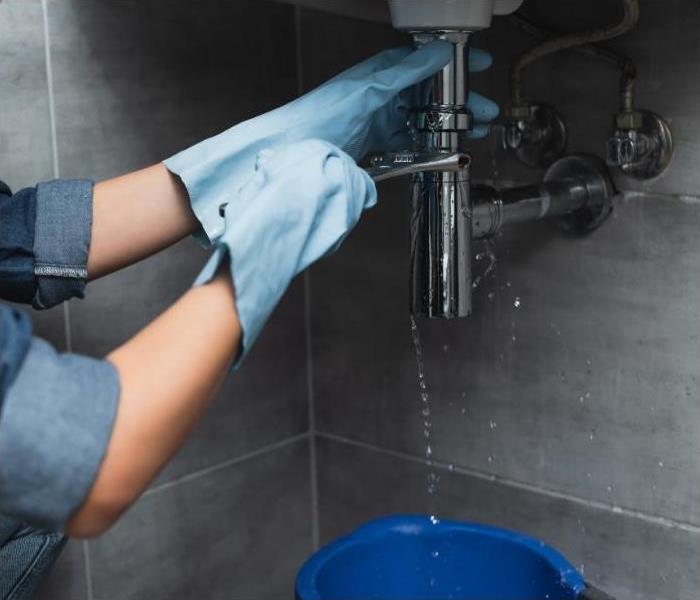 Two common types of water damage are slow persistent leaks and burst pipes.
Two common types of water damage are slow persistent leaks and burst pipes.
Key Takeaways:
- Slow leaks can cause hidden damage over time
- Burst pipes cause immediate and visible damage
- Quick action is necessary for both types of leaks
- Professional restoration can prevent long-term damage and mold growth
When it comes to water damage, prevention is key. Unfortunately, even with the best of intentions, water damage can still occur. When it does, the type of damage and severity can vary. Two common types of water damage are slow persistent leaks and burst pipes. While both can cause significant damage, the severity and urgency of the situation can differ. In this article, we’ll take a closer look at these two types of water damage and discuss how to minimize damage and the importance of calling professional water damage specialists like SERVPRO of South and Northwest Grand Rapids.
Slow Persistent Leaks
Slow persistent leaks are often the result of a small but consistent drip from a faucet, appliance, or pipe. They can also be caused by a faulty seal or a crack in a pipe. While the amount of water may seem minimal, it can add up over time and cause significant damage. The most significant risk of slow persistent leaks is the potential for mold growth. Mold can grow in as little as 24-48 hours and can cause respiratory problems and allergic reactions.
Signs of Slow Persistent Leaks
- Musty odors or visible mold growth
- Stains on walls, floors, or ceilings
- Warping or buckling of floors or walls
- Increased water bill
Minimizing Damage from Slow Persistent Leaks
- Regularly inspect pipes and appliances for leaks
- Fix leaks immediately
- Clean up any water immediately
- Monitor humidity levels and use a dehumidifier if necessary
Burst Pipes
Burst pipes are a much more urgent situation than slow persistent leaks. Burst pipes are typically caused by freezing temperatures or excessive pressure within the pipe. Burst pipes can cause significant damage in a short amount of time and can lead to flooding, which can be dangerous and expensive to repair.
Signs of Burst Pipes
- No water or reduced water pressure
- Water stains or discoloration on ceilings or walls
- Strange noises coming from pipes
- Visible damage to pipes or fittings
Minimizing Damage from Burst Pipes
- Shut off water supply to the affected area
- Call SERVPRO of South and Northwest Grand Rapids immediately for professional water damage restoration
- Turn off electricity to the affected area
- Move valuables and furniture to a dry area
Importance of Calling Professional Water Damage Specialists
Water damage can be devastating, and it’s crucial to call a professional water damage restoration company like SERVPRO of South and Northwest Grand Rapids. Attempting to clean up water damage yourself can be dangerous and lead to further damage. Professional water damage specialists have the knowledge and equipment necessary to minimize damage and prevent mold growth. They can also work with your insurance company to make the restoration process as smooth as possible.
Final Thoughts
Whether it’s a slow persistent leak or a burst pipe, water damage can cause significant damage to your home or business. It’s crucial to take proactive steps to prevent water damage and address any concerns as soon as possible. With water damage, time is of the essence. The longer water damage is left untreated, the more damage it can cause. Call SERVPRO of South and Northwest Grand Rapids for professional water damage restoration.
Is a Leaking Washing Machine Rotting Your Floor?
8/13/2023 (Permalink)
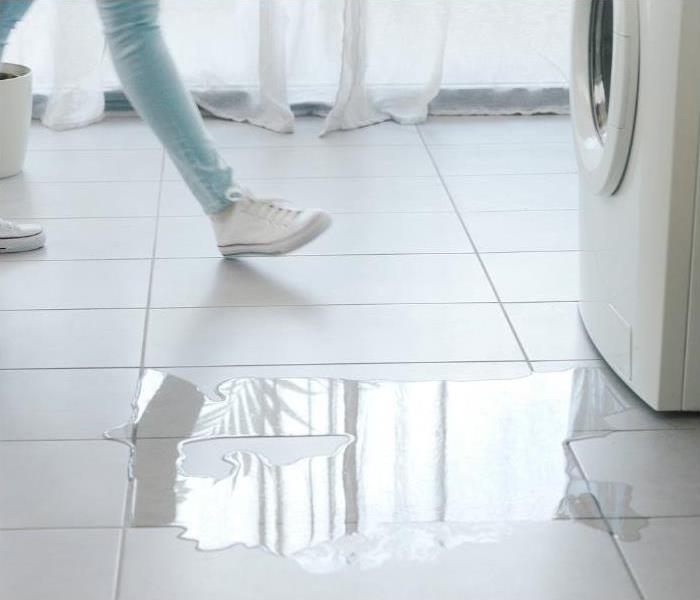 If a washing machine is leaking, how can you tell if your floor is being damaged?
If a washing machine is leaking, how can you tell if your floor is being damaged?
Key Takeaways
- Regularly check for leaks around your washing machine.
- Take proactive steps to prevent water damage.
- Act quickly and call SERVPRO of South and Northwest Grand Rapids water specialists.
- Don’t let water damage cause long-term structural problems.
When it comes to water damage, prevention is key. But when that spigot keeps dripping, or worse yet – a washing machine is leaking, how can you tell if your floor is being damaged? Not only does this type of problem affect your day-to-day convenience, but it can also indicate long-term structural problems requiring expensive repairs.
In this article, we’ll show you how to spot leaks, prevent water damage, and call in SERVPRO of South and Northwest Grand Rapids water specialists to restore your home to its pre-damage condition.
Spotting Leaks
One of the easiest ways to spot leaks is to check for water accumulation around your washing machine regularly. If you notice water on the floor after running your washing machine, it’s time to investigate further.
Another common sign of a leak is a musty odor. When water gets trapped in your floor, it can create a moist environment that promotes mold growth. Mold can cause respiratory issues and further structural damage to your home.
If you notice discoloration on your flooring or walls, this could also indicate water damage. Dark spots or stains are signs of long-term water damage and could be hiding rotting wood or weakened subfloors.
Preventing Water Damage
Preventing water damage starts with taking proactive steps to avoid leaks. Here are some tips to help keep your home safe from water damage:
- Inspect your washing machine regularly. Check hoses and connections for wear and tear, and replace them as needed.
- Make sure your washing machine is level. An unbalanced machine can cause excess vibration, which can loosen hoses and cause leaks.
- Don’t overload your washing machine. Overloading can put a strain on your machine and increase the risk of leaks.
- Monitor your water bill. A sudden spike in your water bill could indicate a leak.
In addition to these preventative measures, it’s a good idea to have SERVPRO of South and Northwest Grand Rapids water specialists inspect your home for potential water damage. They can identify problem areas and offer solutions to help prevent future leaks.
Restoring Water Damage
If you experience water damage, it’s important to act quickly to minimize it. The longer you wait, the more extensive the damage will be.
SERVPRO of South and Northwest Grand Rapids water specialists are trained to handle all types of water damage, from minor leaks to major floods. They use advanced technology and techniques to extract water, dry out affected areas, and restore your home to its pre-damage condition.
They also work closely with your insurance company to ensure you get the coverage you need to repair your home. And they provide 24/7 emergency service, so you can get help when you need it most.
Final Thoughts
Water damage is a serious problem that requires immediate attention. You can avoid expensive repairs and keep your home safe and dry by spotting leaks early, taking preventative measures, and calling in SERVPRO of South and Northwest Grand Rapids water specialists.
Don’t let a leaking washing machine rot your floor. Take action today to prevent water damage and protect your home.
Why Ceiling Stains Are Signs of Water Damage
5/1/2023 (Permalink)
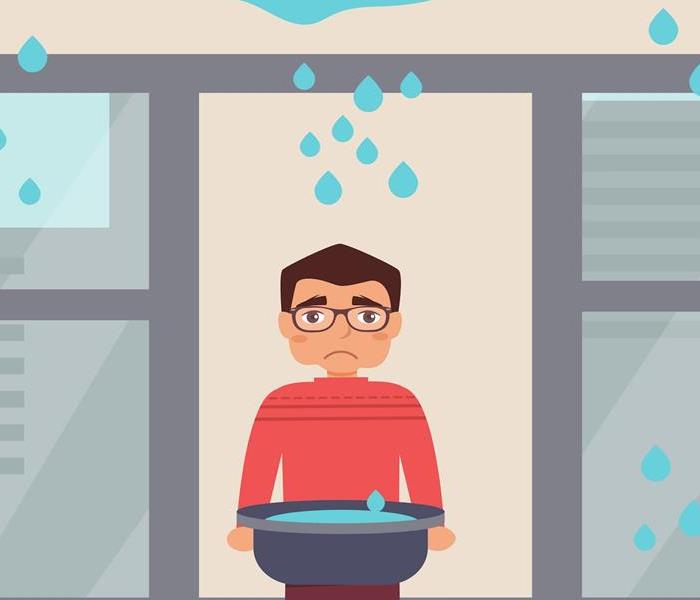 Don't wait until it's too late to investigate a ceiling stain.
Don't wait until it's too late to investigate a ceiling stain.
Key Takeaways:
- Ceiling stains are often a sign of water damage and should be addressed promptly.
- Water damage can lead to structural problems and health risks if left untreated.
- It’s important to identify the source of the water damage to prevent further harm.
- SERVPRO of South and Northwest Grand Rapids offers comprehensive water damage restoration services.
Ceiling stains are a common sight in many homes and buildings, but few people know they can indicate serious water damage. Often, property managers and homeowners ignore ceiling stains, thinking they are nothing more than an aesthetic issue. However, if left unaddressed, ceiling stains can lead to more significant and costly problems. In this article, we explore what causes ceiling stains and why they are signs of water damage.
What Are Ceiling Stains?
Ceiling stains are discolored patches that appear on the ceiling. They often have a yellowish-brown color, but they can also be gray or green. Ceiling stains can take on different shapes, ranging from small circles to large blotches that cover a significant part of the ceiling.
Ceiling stains are typically caused by water damage, but the severity of the damage can vary. Sometimes, ceiling stains are merely cosmetic blemishes, while in others, they can indicate a serious problem that requires immediate attention.
What Causes Ceiling Stains?
There are several potential causes of ceiling stains, including:
Roof Leaks
If your home or building has a roof leak, it can lead to water penetrating through the ceiling and causing stains. Roof leaks can be caused by many factors, including missing shingles, cracked flashing, or clogged gutters.
Plumbing Leaks
Plumbing leaks are another common cause of ceiling stains. If there is a water leak in a pipe that runs through the ceiling, it can cause water to seep through and leave stains. Plumbing leaks can be caused by corroded pipes, loose connections, or clogs.
Condensation
Condensation occurs when warm air meets a cold surface, such as a ceiling. When this happens, moisture can accumulate on the surface and cause stains. Condensation is more common in humid climates or in rooms with poor ventilation.
HVAC Issues
If your HVAC system is not working correctly, it can cause moisture to accumulate on the ceiling and create stains. HVAC issues can include faulty insulation, clogged air filters, or malfunctioning equipment.
Why Are Ceiling Stains Signs of Water Damage?
Ceiling stains are signs of water damage because they indicate that water has penetrated through the ceiling and made its way into the structure of the building. Water damage can be dangerous and costly to repair if left unaddressed. Here are some risks of water damage:
Structural Damage
Water damage can weaken the structural integrity of a building. Over time, water can cause wood to rot and metal to corrode, which can compromise the safety of the building. If water damage is severe, it can even cause the ceiling to collapse.
Mold Growth
Water damage can create a moist environment that is ideal for mold growth. Mold can cause health problems for occupants of the building, including respiratory issues and allergic reactions. Mold can also be challenging and costly to remove once it has taken hold.
Increased Repair Costs
If water damage is left unaddressed, it can lead to more extensive and expensive repairs down the line. Water damage can spread throughout a building, causing damage to walls, floors, and other areas.
What Should You Do If You Suspect Water Damage?
If you notice ceiling stains or suspect that you have water damage in your home or building, it is essential to take action right away.
Water damage can be difficult to assess and repair without the help of a professional restoration company like SERVPRO of South and Northwest Grand Rapids. It is essential to address ceiling stains immediately to prevent further damage and minimize the risk of health hazards.
Final Thoughts
Ceiling stains can indicate water damage, and it is crucial to address the issue promptly to prevent further damage and health hazards. Property managers and homeowners should contact a qualified water damage restoration company, such as SERVPRO of South and Northwest Grand Rapids, for prompt and professional assistance in addressing water damage.
The Importance of Fast Action in Water Damage Restoration
3/13/2023 (Permalink)
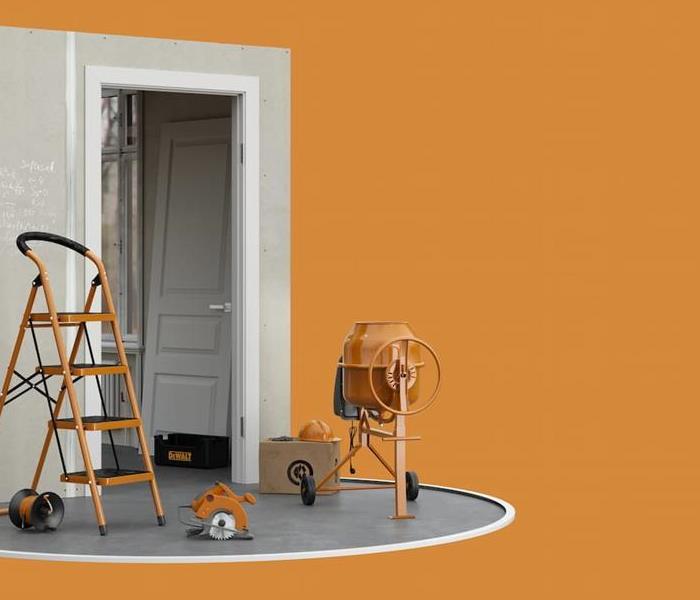 SERVPRO always uses the right tools for the right job.
SERVPRO always uses the right tools for the right job.
Whether from a burst pipe, flooding, leaking roof, or other water-related events, it is essential to take fast action when dealing with water damage to prevent further damage and long-term health risks. Prompt response and proper restoration by an experienced professional can help reduce the loss of property and personal items and the cost of repairs.
Understanding Water Damage
Water damage occurs when water seeps into areas where it isn't supposed to, such as walls, ceilings, floors, and furniture. If left unchecked, the water can cause considerable structural damage that is often expensive to repair or replace. In addition, moisture from water damage can lead to mold growth which can cause many health issues.
Importance of Quick Action
Time is of the essence when dealing with water. The longer water sits in a home or building, the more damage it will cause and the costlier the repairs.
Speed is critical for water damage restoration because water can quickly saturate materials and cause irreparable damage in a very short time. For instance, within minutes, carpets may begin to buckle or discolor, the drywall may start to swell and crumble, metal objects to rust and corrode, and wood furniture can warp or split.
Additionally, fast action when dealing with a water-related disaster helps prevent future damage. For example, if a pipe bursts, the water pressure can cause additional damage to pipes and fixtures. If the problem is not addressed quickly, repairs and replacement expenses can be astronomical.
As water seeps further into the structure of the building, it can cause mold growth which can be hazardous to human health. Acting quickly is essential to limit damages and reduce costs.
Restoration Services
The first step in a water damage restoration process is locating and stopping the leak or flood source. Once that's done, professionals can assess the damages, remove any standing water and dry wet materials, and restore the structure. The right restoration team will have access to specialized equipment such as pumps and extractors, dehumidifiers, and air movers to ensure the job is done quickly, safely, and effectively.
The Benefits of Professional Water Damage Restoration
Water damage restoration should be handled by a professional. A professional water restoration company has the training, knowledge, and tools to assess the extent of the damage and quickly begin the repair process. They can extract standing water, dry out structure materials, remove mold and mildew, and provide other services to bring your home or business to pre-damage condition.
How an Experienced Professional Can Help
When faced with water damage, it is important to hire an experienced professional to ensure everything is done properly and efficiently. An experienced professional will be able to assess the extent of the damage, identify areas that need immediate attention, clean up existing water and moisture, restore damaged items, and make sure all necessary repairs are made.
Furthermore, an experienced professional can help avoid costly mistakes such as not replacing insulation or failing to get rid of mold and mildew. They can also advise on preventing future water damage by suggesting improvements such as installing a sump pump or waterproofing basement walls.
At SERVPRO of South and Northwest Grand Rapids, we are committed to providing prompt and reliable water damage restoration services. Our experienced team of experts is available 24/7 to provide fast responses and quality service. We use specialized equipment to assess the damage, extract standing water, dry out structure materials, sterilize surfaces, remove mold and mildew, repair any items that can be salvaged, and restore your home or business back quickly and effectively to its original condition.
For fast action and quality service regarding water damage restoration, contact SERVPRO of South and Northwest Grand Rapids at (616) 662-9700 with any questions; we're here to help. Our experienced, certified technicians will provide the best service and results. So don't delay; contact us today for fast, reliable water damage restoration services.
Common Causes of Water Damage in Homes and Businesses
3/8/2023 (Permalink)
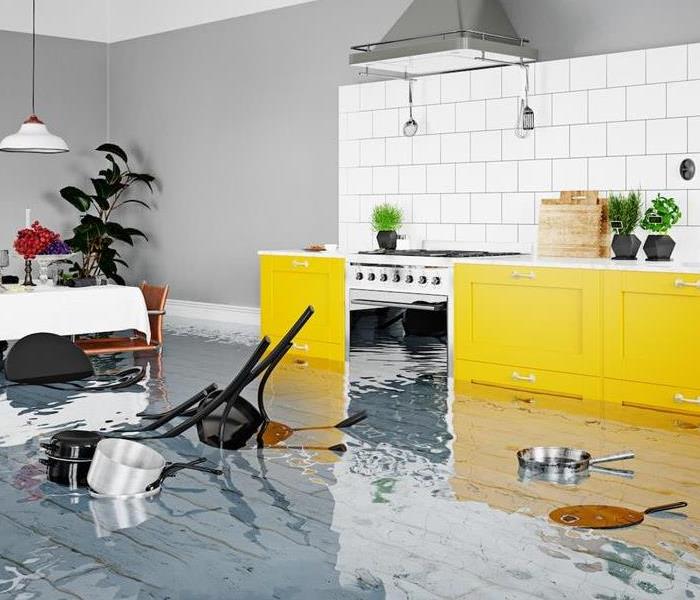 Whether it's your home or business, any water seeping through needs immediate and professional cleanup.
Whether it's your home or business, any water seeping through needs immediate and professional cleanup.
Water damage can occur both inside and outside of your home. You can also be affected by water damage in your business, no matter the industry. It is important to take preventive measures to avoid the risk of water damage. Here is a look at the top common reasons for water damage:
Leaky Roofs or Windows
If your roof is leaking or your windows are broken, water can trickle down and cause damage to the interior of your home or business. You may not even realize that you have a leak until it is too late.
You may have a leak if you notice water stains on the ceiling or walls or a musty smell coming from your home or office. In many cases, a leaky roof or broken window can be repaired quickly and easily. However, if left unattended for an extended period, it can cause serious damage to your property.
Damaged Water Heaters
If you have an old water heater, the chances of it developing a leak are high. When water heaters have not been adequately maintained or are improperly installed, the resulting leaks can cause flooding in basements. With an aging water heater, it is crucial to have it inspected by a professional at least once every two years.
Damaged or Faulty Plumbing
Water supplies run through every part of a home or business, so issues can arise in any location. If you notice that your water is discolored, has a foul smell or taste, or feels itchy after bathing—this may be caused by bacterial growth. Strange sounds coming from the pipes may signal damage to the system.
Appliances, sinks, washing machines, and sprinkler systems are just a few examples of where water damage can occur. Water can create substantial damage when left unchecked if the original installation is substandard.
Clogged Gutters and Drains
Gutter systems are designed to drain rainwater away from your home. Over time, however, gutter systems can become blocked by leaves or other types of debris. When rainwater is prevented from flowing away from your property, it can overflow the edges of gutters and damage ceilings, walls, and floors.
Severe Weather
Though natural disasters like thunderstorms and hurricanes happen infrequently, they can still damage your home. The water damage resulting from severe weather is often the result of roof damage caused by high winds or falling debris. These natural disasters can also result in flooding, which can cause water damage to your property.
The Dangers of Water Damage
Water damage can lead to severe problems in your home, including mold growth and structural damage. Mold is one of the most common types of water damage, as it occurs when moisture gets trapped inside your walls or attic. If left untreated, mold will spread quickly and cause respiratory issues for anyone who suffers from allergies or asthma.
Structural damage is another common by-product of water damage, as water can cause your home's foundation and walls to warp or crack. This can result in structural instability, which could lead to the collapse of your building. The longer you wait to address the issue, the harder it is to repair.
What should you do if you see signs of water damage in your home or business? You don't have to be a plumber or a sailor, but you can call a professional for help, like our friendly and certified technicians at SERVPRO of South and Northwest Grand Rapids. They can safely dry out your building without putting your property (or its residents) in danger! Get in touch with us today by calling (616) 662-9700 with any questions!
The Steps Involved in Water Damage Restoration
3/6/2023 (Permalink)
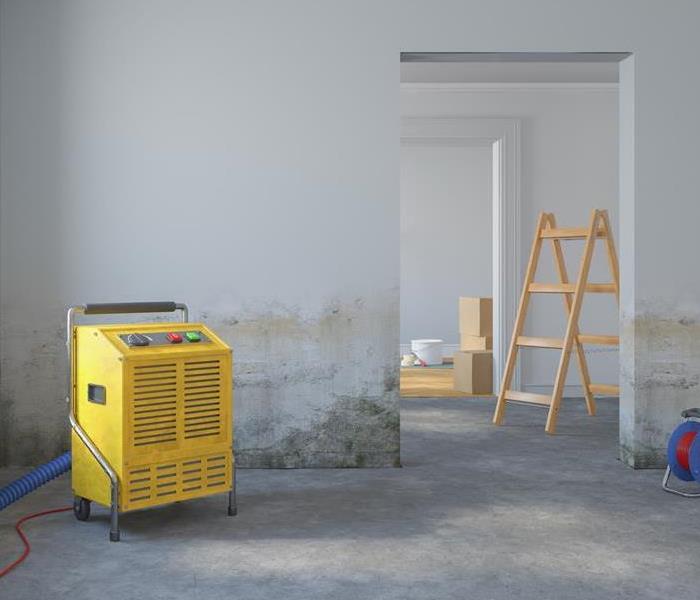 Follow these steps to better understand the scale of water damage restoration efforts.
Follow these steps to better understand the scale of water damage restoration efforts.
Having to deal with water damage is a terrible thing. Not only will you have to do some major clean-up, but you'll also be very frustrated over the costs of fixing your property and the time it takes to get things back to normal. Before you do anything else, you should understand the steps involved in water damage restoration so that all of your bases are covered.
Step 1: Immediate Safety Precautions
When you find water damage, your first step should be to ensure the safety of everyone in the household.
If the source of a water-damage problem is clear, like a pipe leak or flooding from rain or snowmelt, move your family and pets to safety before beginning any clean-up effort. Make arrangements for temporary housing (such as with friends or relatives) while you restore your home.
Before allowing anyone to return to the house, turn off any electric and gas services.
Step 2: Remove Any Excess Water from the Scene
When your home has been flooded, you need to immediately remove excess water. Flooded homes are prone to growing mold and other health issues—and preventing structural damage is essential too! There are several ways to eliminate standing water.
- Ventilating the room by opening windows to facilitate moisture-laden air leaving through evaporation
- Place towels on top of puddles to absorb excess liquid
- Use large commercial fans and dehumidifiers
- Mopping with towels or rags
Step 3: Dispose of Any Items That Cannot Be Restored Due to Extensive Water Damage
Remove any items that cannot be restored due to extensive water damage. This includes books, furniture, clothing, and other belongings. If you can't clean it thoroughly without damaging its quality, throw it away. It is crucial to properly dispose of items that are no longer used to prevent mold growth and illness.
If you are still determining whether an item can be restored or not, consult an expert. The professionals at a restoration company will have the tools and expertise necessary to determine whether your belongings can be saved or not.
Step 4: Drying and Dehumidification
The drying process is the most critical step in water removal. You must thoroughly dry your home to prevent mold growth and health issues. Use dehumidifiers and fans to dry out your property as quickly as possible. If you don't have access to the equipment, consider renting it. Drying times vary depending on your property's type, size, and location.
Step 5: Inspect for Mold
Mold is a common by-product of water damage. It can virtually grow on any surface in as little as 48 hours after a water leak. Mold growth can cause serious health issues and must be removed immediately. A trained professional should inspect your property for mold and other signs of damage, such as dry rot.
Step 6: Cleaning and Disinfecting
Your property will likely smell, especially if the water has been sitting for a few days. You can help eliminate the odor by cleaning your home thoroughly and airing it out.
The cleaning process should include removing all mold and mildew from your property. You should also disinfect all surfaces to kill any remaining mold spores. This will prevent mold growth from recurring.
Step 7: Repair and Restore Your Property
Once the water damage is under control, it's time to start repairs on your property. This may include replacing damaged drywall, furniture, or appliances.
Pro Tip: Hire Professional Restoration Services
If you're unsure how to proceed with cleaning up your water damage, consider hiring a restoration company. These professionals can quickly assess the situation and determine the best course of action. They'll also ensure that any repairs are done properly so as not to cause future issues with mold growth or structural damage.
When disaster strikes and your home is damaged by water, help is just a phone call away. SERVPRO of South and Northwest Grand Rapids will be there for you 24 hours a day, 7 days a week: Call us at (616) 662-9700 with any questions; we're here to help!
The Benefits of Professional Water Damage Restoration
1/30/2023 (Permalink)
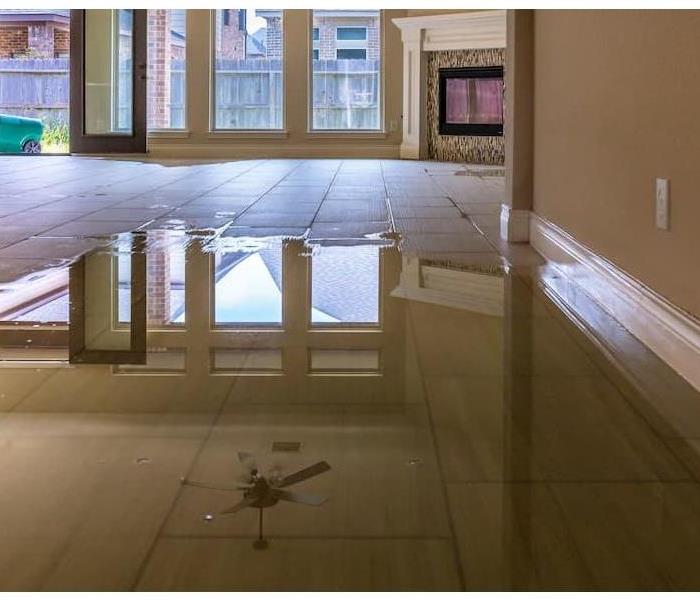 Call a professional any time you see standing water where it shouldn't be. There's likely a bigger problem than you realize.
Call a professional any time you see standing water where it shouldn't be. There's likely a bigger problem than you realize.
Water damage can be a real problem in your home. It can create mold growth, structural damage (wood rot, peeling paint, and other problems), and cause electrical shorts. These risks will lead to more expenditure in the long run — think drywall patches, diverting electrical wires, or even replacing furniture or appliances.
However, if you act quickly enough after experiencing water damage, you can avoid this added expense, not to mention the hassle of cleaning up the aftermath of water damage.
Quick Restoration
Professional water damage services can respond immediately in the event of a flood or other major water damage event. They can also help you restore your property to its original condition, helping to prevent further damage and costly repairs over time.
Professional water damage companies can help you assess the damage and determine the steps you need to take. They also offer preventative measures for future flooding events, so you know your property is protected from further damage.
Safe Mold Remediation
Once water finds its way into your home, mold can develop in as little as 24 to 48 hours. Mold can grow virtually anywhere, from the ceilings to beneath wooden siding. It would be risky for you to try removing mold by yourself since most molds are toxic or irritating allergens.
A professional water damage restoration service can eliminate mold and prevent a recurrence. Water restoration companies ensure that the surfaces are dried and dehumidified to avoid mold infestations. They also use air filtration equipment and employ treatment in an effort to keep growths from recurring.
Lower Structural Damage
Water damage can cause major structural damage to your home by weakening the foundations, damaging walls, and ceilings, and destroying electrical wiring. If your home has been flooded, you should not attempt the clean-up yourself. Not only is it dangerous, but you also run the risk of damaging your home further.
Professional restoration services use specialized equipment and training to safely remove water from your property without causing additional damage.
Prevent Electrical Shorts
The combination of water and electricity can create a dangerous situation. Water can cause electrical shorts by shorting out your home's electrical appliances, equipment, and wiring. This is extremely dangerous because it can lead to fires that can destroy your property and put you at risk of injury or death.
The best way to prevent this from happening is by calling professional restoration services after you experience a flooding incident. The restoration team will evaluate the damage and determine whether the items can be salvaged or must be replaced due to permanent damage caused by liquid exposure.
Help with Insurance Claims
Insurance companies are only sometimes willing to pay for all the repairs needed after a flood or burst pipe. This is where professional services come in handy.
They can provide an estimate of what it would cost to repair everything yourself, then compare it to what they'd charge for the same job if they did all the work themselves. If their estimate is lower than yours (and most likely, it will be), you'll have a better chance of getting your claim approved.
Unfortunately, no one is immune to water damage. Whether the problem is a burst pipe or a broken appliance, it's just one of those things that can happen to anyone. If you experience water damage, you can be sure that a professional restoration company will respond quickly and work around the clock to remedy the problem.
When your home is damaged by water, you need help fast. SERVPRO of South and Northwest Grand Rapids can help. We are available 24 hours a day, 7 days a week. Give us a call at (616) 662-9700 with any questions; we're here to help!
Save Your Documents after Water Damage
12/27/2022 (Permalink)
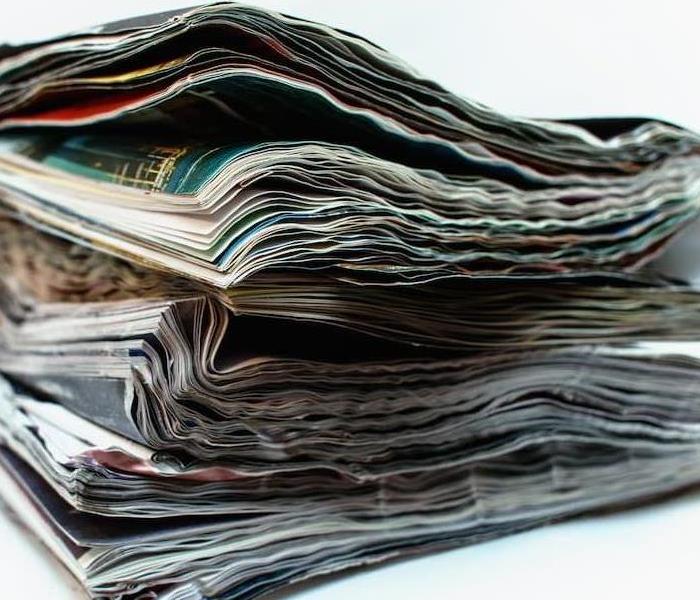 Certain documents can be replaced, but keepsakes require special care.
Certain documents can be replaced, but keepsakes require special care.
It is possible to save and restore water-damaged documents by using various techniques. When faced with a disaster like water damage, it's absolutely necessary to recover any physical documents you own first.
Documents that have been damaged by water need specific drying procedures. Some of the techniques that can be applied are air-drying, freeze-drying, desiccant dehumidifying, and even hand-dry cleaning. These techniques are able to restore photos, business records, and other vital documents not easily replaced. So don't be discouraged if you find your documents wet and soggy. Here are a few tips and techniques to help you save documents after water damage.
How to Dry Loose Sheets
If your papers are wet, you must gently remove them from the water as soon as possible. Be extremely careful while removing them since the papers can easily tear. If the papers have become dirty, clean them using wet tissue paper. Place the individual papers on a plain paper towel - the paper towel must be thick and plain. The wet papers might absorb the print from the paper towel if it isn't plain and could stick to them. Place the documents near an air source such as a fan.
You can also place them under direct sunlight to speed up the process but make sure there isn't any wind. You could also use blotting paper to dry damp spots. Another option is to place them in a freeze dryer to fast-track the drying. Keep changing the drying paper beneath to prevent the papers from sticking together, and hang them up after substantial drying to treat the backside. You can also keep the documents or books in the freezer after placing them in plastic zip locks; this preserves the pages and prevents mold growth.
How to Dry Books
Drying books is a little harder than drying individual sheets of paper, especially if the book is hardbound. Place paper towels between the wet pages and lay the book flat or upside down to facilitate airflow. You can't put paper towels between every page, so place them continuously wherever the pages are most wet. For the other pages, place paper towels between every 20 pages or so. Use a fan to speed up the drying process.
Do not use hot air since it can lead to tearing. Do not keep your book outside since it might curl due to the wind. You can place paper weights on the edges to prevent curling or folding edges. Replace the wet paper towels regularly. If the book smells unpleasant after drying, place it in a closed container with baking soda or odor absorbents. But ensure the powder doesn't touch the book or papers directly.
How to Dry Photos
When drying wet photos, gently remove the photos from the wet area. Clean them using wet tissue paper dipped in cold water. Be careful not to smudge the photos. Place them on a plain paper towel and away from direct sunlight. You can use a fan or desiccant dehumidifier to speed up the process. Once the pictures have dried a little, hang them up to dry the backside. If you're unable to dry them yourself or want to preserve them for longer, consider professional drying that will help with complete restoration.
Drying water-damaged papers, books, documents, and photos is a fairly simple process. Handling the papers with care and taking immediate action will make it easier to restore them. If you ever find yourself in a situation needing to recover water-damaged papers, keep the tips we've given in mind.
When you notice something out of the ordinary, call SERVPRO of South and Northwest Grand Rapids at 616-662-9700. Our professional team will help you with your document recovery.
What Does That Water Stain Indicate?
9/19/2022 (Permalink)
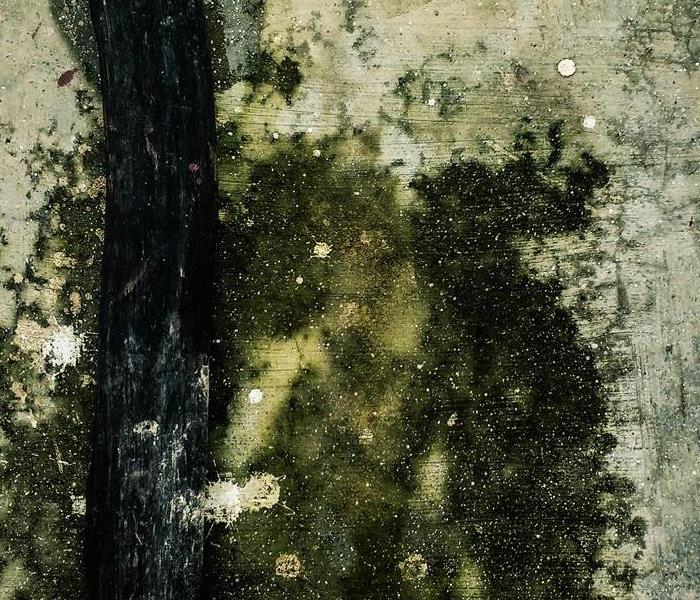 Water, particularly carrying sewage or other liquids, can stain the toughest of surfaces. can stain
Water, particularly carrying sewage or other liquids, can stain the toughest of surfaces. can stain
Water stains can be puzzling. Is that stain from a leaky pipe or just a drop of water that seeped in from the rain? Either way, it's important to get to the bottom of the matter quickly. After all, water damage is one of the most common and costly problems homeowners face.
Here are some of the most common water stains and what they might indicate:
Stains on the Ceiling
You likely have a leaking roof or an issue with your gutters if you notice a water stain on your ceiling. When gutters become clogged with leaves and debris, they can't properly funnel water away from your home. Clogged or broken gutters cause water to back up and seep into your home, leading to water stains on the ceiling.
This leakage can also occur around roof vents, chimneys, and skylights. If you have a water stain on your ceiling, it's imperative to call a professional to diagnose the problem and make the necessary repairs.
Stains on the Walls
Water stains on your walls could be caused by several issues, including leaks in your pipes or roof. If you have a water stain on your wall, it's important to determine the source of the leak, fix it, and prevent further damage.
Stains could also result from condensation, often in homes with poor insulation or ventilation. This water damage is most common in bathrooms, kitchens, and laundry rooms. If you have condensation on your walls, you'll need to improve the home's airflow.
You might also see wall-stains after heavy rains or storms. If water is seeping into your home from the outside, you must waterproof your walls to prevent further damage.
Stains on the Floor
Leaks in pipes or appliances usually cause water stains on your floors. If you have a water heater, washing machine, or dishwasher, frequently check for leaks around these appliances. You should also check the area around your toilets and sinks for leaks.
If you have hardwood floors, water stains can form due to leaks in the roof or windows. If you have tile floors, water stains are usually caused by leaks in the grout or caulking.
Your flooring material is also significant in its susceptibility to water damage. For example, hardwood floors can warp and buckle when exposed to too much water. Tile and linoleum floors are more resistant to water damage, but they can still be stained by water.
Water can seep through cracks in tile or wooden floors, causing the material to swell and discolor. If you have water stains on your floor, it's important to determine the source of the leak and fix it immediately to prevent further damage.
Stains around Windows
If you notice water stains around your windows, it's likely due to condensation. When warm air inside your home hits a cold windowpane, it causes water to condense and form a stain.
You'll need to improve the insulation in your home to prevent condensation stains. This can be done by adding weather-stripping around your windows and doors. You should also open your curtains and blinds during the day to allow sunlight and improve air circulation.
Brown or Yellow Stains
If you notice brown or yellow stains on your walls, ceiling, or floors, it's likely due to rust. These stains are most commonly seen in homes with metal pipes. If you have galvanized steel or iron pipes, they could be rusting on the inside and causing these stains.
It's imperative to have rusty pipes replaced as soon as possible, as rust can cause your pipes to leak and lead to expensive repairs.
It's important to determine the source of the leak when you notice any water stains in your home and make the necessary repairs. Water stains are caused by several issues, including leaks in your roof, windows, or pipes.
These leakages can be devastating if not fixed immediately, so it's crucial to call a professional. For more information or to schedule a consultation, call SERVPRO of South and Northwest Grand Rapids at 616-622-9700 and let them help you get your home back to normal.
Watch Out for Heavy Rains and Sewage Backup
8/8/2022 (Permalink)
If you live in an urban area, you probably have a network of underground sewers carrying wastewater away from your home. These sewers are designed to handle a certain volume of water but can become overwhelmed during heavy rains. As a result, sewage can back up into your home through drains or toilets, creating a messy and potentially dangerous situation. You can do a few things to help prevent sewer backups.
Install Check Valves
No one wants to deal with a sewage backup, so it's important to take steps to prevent one from happening in your basement. Check valves are important in flood prevention because they close when water starts flowing backward. It prevents sewage and stormwater from coming back up through your drains and into your home. You can get check valves installed by a professional or purchase them at most hardware stores. By taking this simple step, you keep your basement dry and free of potential sewage backups.
Install Sump Pump
When sewage backs up in your home, it is usually a nightmare. Not only is it a gross mess, but it can also pose a serious health risk to you and your family. Fortunately, there is a way to protect your home from sewer backups: by installing a sump pump. A sump pump is a small pump installed in the lowest point of your basement or crawlspace. When water accumulates in the sump pit, the pump automatically turns on and removes the water; this helps prevent the water from rising and flooding your home. In addition, sump pumps can also help protect your home from foundation damage by preventing water from seeping into the soil around your foundation. So, install a sump pump if you want to keep your home safe from sewage backups and floods.
Install Rain Gutters and Downspouts
Installing rain gutters and downspouts can help prevent sewage backups during heavy rains. Gutters collect rainwater from your roof and channel it away from your foundation, while downspouts direct the water even further away from your home. They help reduce the water that saturates the ground around your sewer line, making it less likely to back up. In addition, you should also consider installing a backflow valve in your sewer line. This device prevents sewage and wastewater from flowing back into your home, even if the main sewer line has overflowed.
Call a Professional
Sewage systems are designed to handle a certain amount of water; when they are overloaded, they can back up into your home or business. Heavy rains are often the cause, as the rainwater can overwhelm the sewers, causing a backup. It's important to call a professional if you live in an area prone to heavy rains to help prevent this from happening. If you notice sewage backup call a professional service like SERVPRO of South and Northwest Grand Rapids. We have the training and experience to safely clean and restore your property. We are available 24 hours a day to help. Call us at 616-662-9700 to get your cleanup started.
SERVPRO will inspect your system and ensure it is in good working condition. We might also recommend some changes you can make to help reduce the risk of sewage backup.
Sewage backups can be a messy and smelly problem, but more importantly, they pose severe health risks for you, your family, and your pets. Moreover, the damage to your home could be equally disastrous and very costly. However, by following these simple tips, you can tackle the issue quickly and effectively and keep your home clean and free of sewage backups.
Effects of Standing Water in and around the House
7/6/2022 (Permalink)
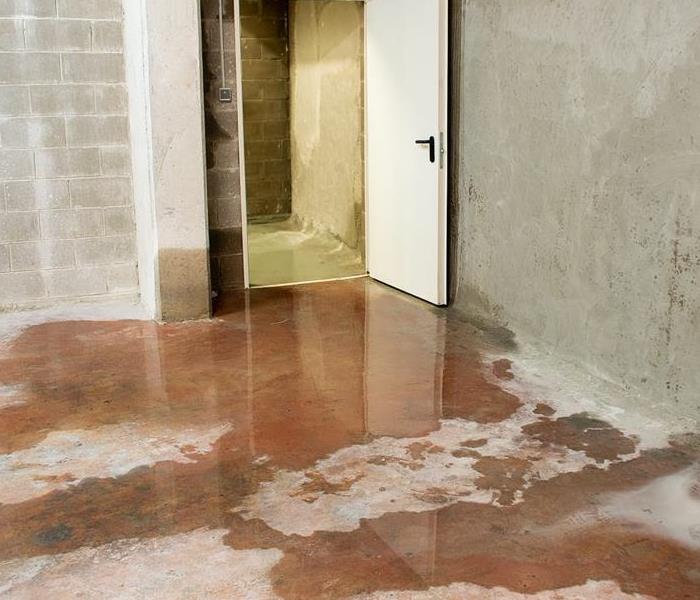 Standing water in the most sturdy of structures is still cause for alarm.
Standing water in the most sturdy of structures is still cause for alarm.
Water is life for all living beings, but stagnant or standing water is a sign for Michigan homeowners that there are issues with drainage and water management on their property. If you see standing water in or around your house, you shouldn't ignore it or think it will go away by itself. Ignoring standing water can cause various dangers to you and your family. Additionally, standing water is a symptom of a bigger underlying problem or problems that must be addressed as soon as possible.
Here are some effects of standing water you must be aware of.
Attracts Insects and Pests
Standing water is ideal for insect breeding as they need wet conditions to thrive. Insects like mosquitoes, ants, cockroaches, termites, and ticks reproduce in wet conditions. Insect infestation in or around your house is dangerous as it carries various diseases. Vermin, like mice, rats, and possums, also look for wet places and cause severe problems and inconveniences, such as spreading diseases, biting, and leaving waste.
Mold Growth
Mold and mildew grow in standing water. Wet conditions in your house allow mold to produce poor air quality and ruin furniture, clothes, and other items with porous surfaces. Mold makes your house smell unpleasant and causes a wide range of diseases, some critical. Removing mold is a complicated process that takes a lot of time and money while putting your health at risk, so it's better to prevent it from spreading by immediately getting rid of standing water.
Causes Foundation Damage
Standing water will seep into your house foundation if left unattended for a long period and cause shifting and bowing of your home structure. Whether the standing water is in your house or around it, it can lead to the breakdown of your home's foundation. Structural collapse can happen if the problem is ignored for a long time. Signs that your house has foundation problems include stuck doors and windows, concrete cracks, squeaking floorboards, tilting chimneys, and uneven floors.
Electrical Hazard
It is known that water and electricity don't mix well. Therefore, standing water in your house is an electrical hazard as any electronic system can cause an electric shock to anyone touching the water. Water will damage various home systems, such as the furnace, air-conditioning units, and water heater, and react with their electrical parts. It will be expensive to repair these systems, and the structural damage caused by standing water and the electrical hazard is too dangerous to ignore.
How to Prevent Standing Water
Homeowners in Michigan need to prevent water leakage in or around their houses. Ensure your roof drainage is unobstructed; the downspout will drain water away from your home foundation. If you have sprinklers, ensure that they are working properly and make them run less than usual if there is standing water around them.
If water is leaking inside your house, find the source of the leak and fix it as soon as possible. Shut off the water valves once you have located the source and clean up the water as much as possible. If you don't know how to fix the water leak, call a professional soonest.
Standing water causes a wide range of problems, such as health risks, structural damage, and unpleasant living conditions. It attracts insects, vermin, and bacteria that carry life-threatening diseases like E.coli, Zika virus, and more. Tackling the problem in its early stages to prevent these problems is crucial. Ensure your drainage inside and outside your house is working properly and nothing leaks water.
Keep your family safe by preventing standing water from forming in or around your house. And when you notice something out of the ordinary, call SERVPRO of South and Northwest Grand Rapids at 616-662-9700.
How to Prepare for Snowmelt
3/30/2022 (Permalink)
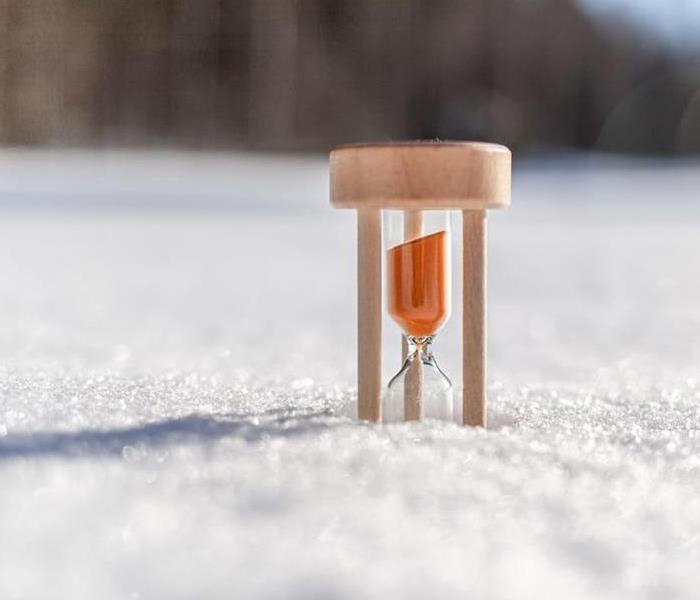 Spring snow melt can cause water damage.
Spring snow melt can cause water damage.
This recent Michigan winter has seen some interesting fluctuations in weather, both in terms of the temperature and the precipitation. Snowstorms have been followed by warmer, sunny days, which quickly eliminate the snow that had piled up. Then, it all happened again with another couple inches of snow falling just days later. Even though the weather may be a tad unpredictable, there are plenty of things you can do when it comes to snowmelt preparation and protecting your home.
Believe it or not, the earliest prep you can do for melting snow can come way before the first snowflakes drop. During the fall, you will want to be sure that your gutters are clean and clear from leaves and other debris. Melting snow can end up refreezing in the gutters, which can cause roof ice dams and damage your home.
Ice dams will form when the temperature in your attic or higher levels in the house are above freezing, and the snow on the roof melts and flows down the roof. Once the melted snow hits colder areas, like overhangs or gutters, it refreezes. Ice dams will cause water to pool, and if given enough time, that water can back up into your home through the roof shingles, leading to water damage to ceilings and walls.
Along with making sure your gutters are clear, preventing ice dams requires more snow removal and maintenance than normal. Keeping the amount of snow on your roof to a minimum can be tricky, but by using a roof rake, or a long-handled shovel, can pull heavy loads of snow off the roof. Inside your home, improving the insulation and ventilation in your attic can also help limit or prevent the occurrence of roof ice dams.
Throughout the winter, you will need to be ready to prepare both the inside and outside of your home. Michigan homeowners know the routine when it comes to clearing snow from their driveways and sidewalks, but the last thing you want to do is pile snow against the side of your home. As that snow melts, the water can go straight to the foundation.
Other areas that need to stay clear of snow include stairwells, window wells and egress exits. Drains near these areas also need to be kept clear so water can be redirected away from your home and not into the basement. Also, your sump pump discharge lines need to lead to a slope and not to an area where the water can accumulate and freeze.
Start with the sump pump when you do your indoor preparation, and perform any maintenance that it may require before a winter emergency can arrive. Next, as you inspect areas in the walls and flooring, repair any cracks and fill joints or other spaces before they can get worse. Any waterproofing that can be done should be done.
Lastly, as the temperatures steadily get higher and we move into spring, you will want to do an inspection of those areas that could have been affected by the snow melt. The gutters are the most likely victims to have been hurt by snow and ice, and repairs to the gutters should happen before the rain comes. Your landscaping also may need to be refreshed, and fixes to the grading should be done to help direct water away from your home.
No matter what you might be facing this season, SERVPRO of South and Northwest Grand Rapids is here to help you recover as quickly as possible. For more information on protecting your home from melting snow, call SERVPRO of South and Northwest Grand Rapids today at (616) 662-9700. Our specialties include fire, water, and storm damage restoration for residential and commercial clients. We also do mold and mildew remediation and much more.
What Are Some DIY Tips To Mitigate Water Damage To Your Ada Home Until Help Arrives?
3/8/2022 (Permalink)
Water damage to your home is never fun. It can cause severe problems and unsafe conditions and sometimes compromise your health due to unclean water or mold infestation. When a flooding event of any size occurs in your Ada home, you will want to take immediate steps to manage it, even if you plan on getting help from a professional water damage restoration company like SERVPRO.
Keep reading to learn more about some things you can do yourself to mitigate water damage to your Ada home while you wait for the restoration professionals to arrive!
What Should I Do First When My Ada Home Experiences Water Damage?
After any water damage situation, your primary focus should be safety first:
- Ask yourself if it is safe to stay in the house; if you are unsure, clear the premises of anyone who could be injured.
- Electrical and "slip and fall" hazards are the most prevalent concerns you will face.
- Only do activities that are safe for you to perform, and be sure to avoid plugging in any tools in wet conditions.
- Wet materials can be weighty, so you will want to exercise caution when attempting to move items that have been affected.
What Are Some Do's and Don't’s For Me To Keep In Mind While I Am Handling Water Damage Aftermath?
What To Do After Flooding:
- Remove excess water by mopping and blotting.
- Wipe excess water from wood furniture after removal of lamps and tabletop items.
- Remove and prop wet upholstery and cushions.
- Place aluminum foil or wood blocks between furniture legs and wet carpeting.
- Turn air conditioning on for maximum drying in summer.
- Remove colored rugs from wet carpeting.
- Remove art objects to a safe, dry place.
- Gather loose items from floors.
What NOT To Do After Flooding:
- Don't leave wet fabrics in place; hang furs and leather goods.
- Don't leave books, magazines, or other colored items on wet carpet or floors.
- Don't use your household vacuum to remove water.
- Don't use television or other household appliances.
- Don't turn on ceiling fixtures if the ceiling is wet, and keep out of rooms where ceilings are sagging.
Here at SERVPRO of South and Northwest Grand Rapids, we can be onsite at your Ada home right away to help you get started on your recovery. In addition to water damage, we handle storm damage, mold remediation, odor removal, and much more.
When you hire SERVPRO to handle any disaster at your Ada residence, large or small, you can count on our 24-Hour Emergency Service. We are Highly Trained Water Restoration Technicians and trusted leaders in the water restoration industry. We employ advanced water inspection, extraction, and drying equipment, and our franchise is independently owned and operated.
What Are Some Dos And Don’ts If You Experience Water Damage In Your Walker Business?
12/28/2021 (Permalink)
After any water damage situation, your primary focus should always be safety first. If the flooding is extensive, you need to ensure it's safe for everyone to stay in the building; water damage can create dangerous structural issues. As everyone knows, electricity and water are a bad combination, so that's another thing to watch out for. When moving about the premises, you will want to guard against slip and fall accidents.
You may decide to begin cleaning up the mess yourself, but please keep in mind that wet materials can be far heavier than they are when they are dry. Know your limits, and only do what you know you can do safely. Engaging the help of a restoration specialist like SERVPRO can be a wise choice that will allow you to avoid unfortunate accidents. We can be onsite at your Walker commercial location right away to start your water damage recovery process.
What Are Some Steps I Can Take If My Walker Business Is Affected By Water Damage?
Some "dos" when handling water damage to your commercial location:
- Do remove excess water by mopping and blotting.
- Do wipe excess water from wood furniture after removal of lamps and tabletop items.
- Do remove and prop wet upholstery and cushions.
- Do place aluminum foil or wood blocks between furniture legs and wet carpeting.
- Do turn air conditioning on for maximum drying in summer.
- Do remove colored rugs from wet carpeting.
- Do remove art objects to a safe, dry place.
- Do gather up loose items from floors.
What Are Some Tasks I Need To Avoid When Managing Water Damage At My Commercial Location In Walker?
Here are some definite "don'ts" to be mindful of while recovering your property from a water damage event:
- Don't leave wet fabrics in place.
- Don't leave books, magazines, or other colored items on wet carpet or floors.
- Don't use a regular vacuum to remove water.
- Don't use computers or other appliances.
- Don't turn on ceiling fixtures if the ceiling is wet, and keep out of rooms where ceilings are sagging.
SERVPRO of South and Northwest Grand Rapids is here to help you with emergencies and disasters of all types and sizes. In addition to water damage, we handle fire damage, mold remediation, odor removal and deodorization, biohazards, and more!
This franchise is independently owned and operated.
What Are The Top Three Places To Check For Water Damage In My Caledonia Home?
9/17/2021 (Permalink)
Conducting regular inspections of areas in your Caledonia, Michigan home or business most likely to experience water damage will allow you to take care of issues before they become serious. Some spaces are more likely to be affected than others, of course, so these are the places you need to direct your focus. Water damage can occur with little-to-no warning, creating damp conditions that are just right for a mold colony, and leaving you with an unsafe and unhealthy environment.
Which Areas Are Most Prone To Water Damage In My Caledonia Home?
The bathroom. Most bathrooms get cleaned thoroughly at least once a week, and this is the perfect time to check for leaks and damp areas. Look in the least-traveled spots, such as corners of the linen closet, behind the toilet, under the sink. If you find leaks, they will need to be fully dried out and the water source determined so that repairs can be made. You can invest in a dehumidifier, which will be very helpful in reducing humidity.
The kitchen. This area of the home is used more than any other area in homes. Watch for spills and leaks and clean them up immediately to ensure that wet conditions are not attracting mold spores, which are always in our air. Under the sink or refrigerator you may find areas damaged by water without you noticing, so get out your flashlight to be sure you can see every corner.
The laundry room. An unnoticed leak behind the washing machine can create huge issues over time. Pull the washer and dryer out from the wall regularly, and make sure the areas behind them are clean, dry, and disinfected.
Other areas you may want to inspect regularly for water damage: hall closets, garage, and basement.
What Other Water Damage-Related Services Does SERVPRO of South and Northwest Grand Rapids Offer?
Other related issues may evolve from a water damage episode, such as structural deterioration, mold infestation, unhealthy conditions, or unpleasant odors. In addition to water damage restoration, our company also help manage such related services as:
SERVPRO of South and Northwest Grand Rapids is always here to help you with any issues related to water damage in your Caledonia home or business. Large-scale cleanups after storm damage and fire damage are our specialties, and we are commercial restoration experts, too.
We can get your home or business Certified: SERVPRO Cleaned, as well. This franchise is independently owned and operated.
How Do I Inspect My Water Heater In Grand Rapids?
8/10/2021 (Permalink)
No one likes going without hot water, especially when it happens unexpectedly. Your water heater can stop working with little notice, leaving you with an uncomfortable situation!
One of the best ways to avoid this kind of experience is to inspect your water heater regularly. This practice will help you stay on top of any maintenance issues and make replacements or repairs ahead of time, allowing you to avoid leaks, drips, and water damage.
What Should I Look For When I Inspect My Water Heater?
- Find the age of your unit by looking for the serial number on the manufacturer sticker on the upper portion of the water heater. Each manufacturer has a similar date code, and they can vary, so check the manufacturer's website to date your machine. If your water heater is more than ten years old, you may want to consider replacing it, especially if its location means a leak will cause you water damage.
- If you see rusty water coming from the hot side piping in your home, this is a sign that your water heater is rusting away on the inside and may begin to leak soon. Test first to see if it is coming from galvanized pipes, if you have those, by draining a few buckets of hot water from the water heater. If the water gradually clears, it isn't your water heater.
- Sediment will build up at the bottom of your water heater tank over time. As the sediment is heated and reheated, it eventually will harden and cause rumbling noises to develop; that is another sign that your water heater needs to be replaced soon to avoid water damage from leaks.
- If you notice moisture around your water heater, you may have a small leak or a fracture in the tank.
What Do I Do If I Find An Issue During The Inspection Of My Grand Rapids Water Heater?
If you are concerned about the failure of your water heater or if you discover any signs of trouble:
- Try not to panic
- Make sure you know exactly where the leak originates
- Turn off the water to your water heater unit
- Drain the tank if you are confident you can do this safely:
- Open some of your hot water taps around the house, preferably those located on floor levels above the heater
- Locate the drain valve near the bottom of your water heater
- Attach a garden hose to the drain valve and run the hose to a place it can drain safely, like a floor drain or your driveway
- Open the drain valve and let the water start flowing. Generally, this step takes 10 minutes or less
- Once the tank is empty, disconnect the hose and close both the drain valve and the hot water taps you opened in the first step
- Call a plumber
- Call your restoration specialist if you have experienced water damage
We are always ready to help you if water damage occurs in your home or business. Our SERVPRO of South and Northwest Grand Rapids technicians are highly trained and skilled in all types of restoration and cleanup projects, including mold remediation - which is often an unfortunate and unpleasant side-effect of water leaks.
We can get your home or business Certified: SERVPRO Cleaned, as well. Ask us how!
This franchise is Independently Owned and Operated.
How To Prevent Water Damage In Your Bathroom
6/1/2021 (Permalink)
Your bathroom is probably the most vulnerable area in your home or business when it comes to damage from water, and that only makes sense. To prevent such damage from occurring, you will want to do regular assessments of pipes, faucets and fixtures, caulking, and more. If you can identify aging equipment and replace it before it fails, you will avoid the most common causes of water damage in your bathroom.
Here is a great list of things to look for:
- You may notice wallpaper or paint peeling away or appearing discolored in your bath area. Check for bowing in the walls, which can be a result of long-term seepage. If the flooring is swollen or removed from the subfloor, that is another indicator of water seepage. If any of these signs appear, it’s important to find the source of the leak.
- Look for cracks in window seals and door panes, as well.
- Odors are a powerful indicator that there is an excess water problem. Oftentimes, it’s mold or mildew that causes those smells, so look in those hard-to-see places, such as under the sink, behind the toilet, and in the closet.
- Make a regular inspection of pipes and hoses; if you see one that is getting old, replace it BEFORE it fails. Waiting until it breaks will mean a water damage event, which you want to avoid.
- If you do experience flooding in your bathroom, such as from a toilet backing up or a bathtub overflowing, make sure you remove the standing water right away. Employ fans if you can (be sure not to plug them in until you know that there is no dampness in the wall); these will help to speed up the drying process.
Call the professionals at SERVPRO if the worst happens; we’re experienced and trained to remediate and repair areas that have extensive damage from excess water due to leaky pipes, flooding, etc. Our team here at SERVPRO of South and Northwest Grand Rapids is here to help with cleanups after water damage or fire damage, and we handle mold invasions, biohazards, vandalism, and more. We can get your home or business Certified: SERVPRO Cleaned, too! This franchise is independently owned and operated.
What To Do If Your Basement Floods
3/23/2021 (Permalink)
Since your basement is often used for storage, vulnerable items such as electronics, textiles, and items made with paper will be damaged if they become water-logged from a flooding event. Once that happens, you may find yourself with a lot of personal belongings that could be lost forever, and employing the help of a professional restoration can keep that from happening. They can also assist with mold and mildew remediation, water removal, structure repair, and other flooding-related issues.
Today we have some tips that can help you know what to do if your basement floods.
Call The Professionals
First, make sure anyone who is involved is safe, and being careful in navigating the situation. If you have a large amount of standing water in your basement, call your power company, electrician, and/or your professional water damage cleanup team immediately. These professionals have the tools and training to handle the situation properly and will be able to determine the safest steps to take in beginning the cleanup process without increasing the risk of fire damage exposed wiring, etc.
Increase and Sustain Air Flow
You can use your shop-vac to clean up smaller amounts of standing water while you are waiting for the professionals to arrive. Once the water is removed, a dehumidifier or fans can be used to circulate air to discourage mold growth and mildew. Make sure to keep any machinery at least eight inches away from walls to allow for the best circulation possible. Your air conditioning can be a big help here; keep it running throughout the building for further help in discouraging a mold colony from starting.
Use Cleaning Solution
Another way to keep mold from taking advantage of damp surfaces is by scrubbing them with a solution of one cup bleach to one gallon of water; be sure to wear gloves and protective eyewear during this process, and don’t forget to keep the room ventilated while you are using cleaning solutions.
You don’t have space anywhere else in your home or business to store excess items, so using air- and water-tight plastic bins will protect your items against a future flooding event.
Here at SERVPRO of South and Northwest Grand Rapids, we have all the skills necessary to be able to help whenever you experience water damage or fire damage, and we are mold and mildew remediation specialists, too. We handle large cleanup projects for commercial business owners and smaller projects for area homeowners, and we can get your premises Certified: SERVPRO Cleaned! This franchise is independently owned and operated.
What Happens After Water Damage?
1/25/2021 (Permalink)
Water damage of any kind can be devastating to your home or business. Structures, tools, documents, and household items can be compromised or lost this way, and depending on the extent of the water involved, your losses can be significant.
If your water damage is relatively small - such as a small leak under a sink or appliance - you can handle that fairly easily. You can expect to have some water to remove and some repairs to pipes or water lines to complete; you can do this yourself in most situations. If the water leak has been going on for some time, you may have a mold colony growing. This will almost certainly require the services of a professional mold remediation company since once mold gets established, it can never be completely eradicated. Choose a company that has the training and equipment needed to get your mold remediation project done right.
If your water damage is extensive your building structures may be compromised and even unsafe. You can inspect your premises yourself, but it would be wise to engage a professional construction company to come and do a thorough inspection. There may be some small repairs that you can do yourself, but keep in mind that this may affect any insurance claims. Know your policy and requirements before the worst happens so that you can ensure your coverage is not affected by any actions you may decide to take.
Documents that are stored where water can reach them will be adversely affected by damp conditions as well as the water itself. Storage for your paper documents needs to be properly addressed before a flooding event or damp conditions present themselves, and if you have already experienced such an event and you are faced with damaged documents, you can connect with a professional document restoration service to recover them if at all possible.
Many different situations can arise after water damage, but no matter what you are experiencing, you can always depend on SERVPRO of South and Northwest Grand Rapids to help you clean up and recover. We can get your home or business Certified: SERVPRO Cleaned, too - ask us how. This franchise is independently owned and operated.
When your home gives you a "Surprise Party"
1/22/2021 (Permalink)
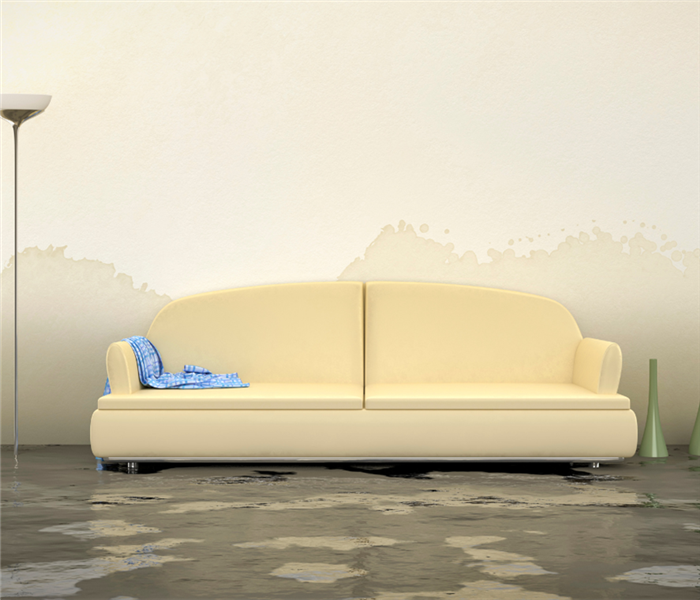 Your SERVPRO team has tackled circumstances like this one, and much worse. We will be there for you when you need us.
Your SERVPRO team has tackled circumstances like this one, and much worse. We will be there for you when you need us.
Imagine…
It’s 8:00 p.m. on a Sunday, and you walk into your home after a relaxing vacation expecting to switch on the lights, put the kids to bed then get some rest yourself. Much to your dismay, a water pipe burst over the weekend, dumping thousands of gallons of water over your hardwood kitchen floor, your carpeted living room, and it is raining water in your basement. SURPRISE!!! The problem is far beyond handling on your own. What do you do now?
Here to help 24/7
When it is your home or business that is underwater, time is of the essence. You need professional water damage restoration to begin immediately. Since SERVPRO of South and Northwest Grand Rapids has someone on call for emergencies 24/7/365, you can call us any time at 616-662-9700.
The cost of water damages can increase exponentially with time. Wood Floors warp, dry wall soaks in moisture and mold develops in hard-to-reach areas of your home or business. The team members at SERVPRO of South and Northwest Grand Rapids are experts at assessing what measures need to be taken to minimize damage and get you back to normal asap.
If the unthinkable happens to your home or business, allow SERVPRO of South and Northwest Grand Rapids to help quickly turn your “before” into a “happily ever after.”
What To Do If An Appliance Is Leaking
12/1/2020 (Permalink)
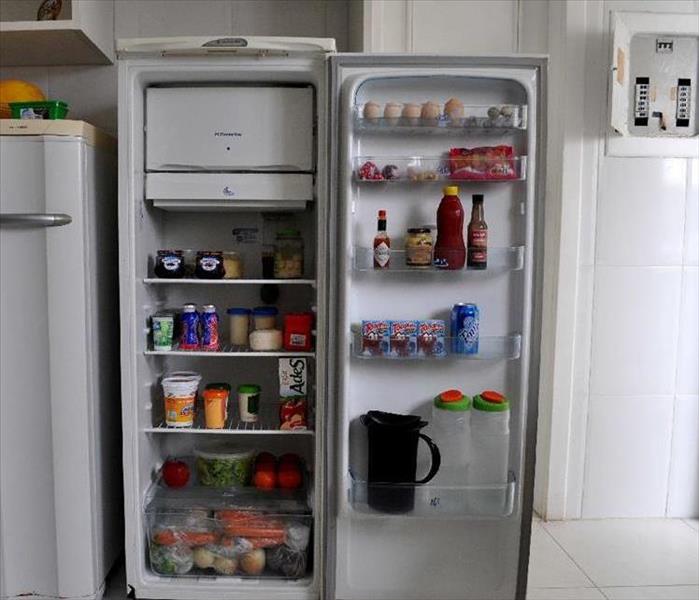 While refrigerators and dishwashers are fixtures in almost every kitchen in Grand Rapids, they are frequently the cause of water damage.
While refrigerators and dishwashers are fixtures in almost every kitchen in Grand Rapids, they are frequently the cause of water damage.
Your household or business kitchen appliances can spring a leak and go undetected for quite a while. If the leak has been slowly developing over time with small amounts of water dripping, you may also find yourself with a mold infestation, as well. Mold requires a food source, moisture, and time to grow. Therefore a slow leak can create the perfect conditions for mold growth.
If this happens to you and you find yourself asking what you should do if an appliance is leaking, we’ve got a few answers and tips for you below.
Minor Leak - Dripping/Puddle
If a small leak has been detected, follow these simple steps to protect your flooring and any items around the leak that could be negatively affected:
- Turn off the water supply to the appliance. A small issue can quickly become a big deal if circumstances should change.
- Soak up any access water on the floor and surrounding areas with a towel.
- If the appliance can easily be repaired, feel free to fix the issue, otherwise call your appliance repair professional right away for their expertise.
- Lastly have a trusted restoration company send a trained technician to evaluate if there is any remaining moisture below the surface of the floor and walls. In most circumstances, charges do not come into play until remediation begins.
Major Leak - Standing Water
- Turn off the water supply to the appliance immediately. If you are not sure where the water originally came from shut off water to the entire house/business and locate the source.
- Call your appliance repair professional right away for their expertise on whether the appliance should be repaired or replaced, as well as gauging the likelihood of a similar loss in the future.
- Call your local restoration company as quickly as possible. Time is money. If water has been standing for any period of time you will likely have some damage to flooring, walls, or personal belongings.
Your cleanup and repair professionals can be onsite in no time to get your home or business back to normal. If you find that paper files and documents have been affected, a professional restoration company will have the equipment and training to be able to save them in most cases, for example.
SERVPRO of South and Northwest Grand Rapids is ready and waiting to help you 24/7 with any kind of water-related issues, and we handle repairs and renovations related to fire damage, as well. Mold remediation and prevention is another one of the areas where we excel by maintaining the training and skills necessary to properly manage this particular kind of cleanup project.
How Long Does It Take For Mold To Grow After Water Damage?
9/22/2020 (Permalink)
You may have experienced a flooding event in the past due to bad weather or equipment failure of some kind. There are many issues that can result from this kind of damage that can last well into the future if the cleanup is not done correctly.
All belongings must be thoroughly dried and restored. This will often require the assistance of a professional cleanup and restoration company. Here at SERVPRO, we are experienced in assisting our customers with situations of this kind. We can help to recover your possessions if they have been damaged by water. This includes furniture, technological equipment, and even documents.
Another concern is mold, of course. After a flooding event, mold can establish a colony in the darkest, damp corners before you even know it has happened. If you don’t know much about mold, you may be asking yourself how long it takes for mold to grow after water damage. The answer? Not very long at all.
After a flood in your home or business, a mold colony can establish itself within 24 to 48 hours, and once a colony has been established, it can never be completely eradicated. Therefore, it is extremely important for you to make sure your premises are dried and restored completely as soon as possible after a flooding event.
Here at SERVPRO of South and Northwest Grand Rapids, we care about you, your family, and your business. When the worst happens, we can be there right away to handle any kind of disaster you may have experienced. Mold prevention/remediation is one of our specialities, and we handle water damage and fire damage, as well. We can get your home or business Certified: SERVPRO Cleaned!
What To Do In Case Of A Water Leak In Your Bathroom
7/28/2020 (Permalink)
A leak in the bathroom can happen quietly, over time, or they can show up suddenly with no warning. Either way, these leaks can cause a lot of water damage to any home or business owner. You will want to determine where the leak is coming from right away so that you can prevent as much damage as possible, and here at SERVPRO of South and Northwest Grand Rapids, we have some tips for you.
Today we are sharing some things you can do in case of a water leak in your bathroom:
The first step is to find the bathroom leak, so you will need to inspect your bathroom for those telltale signs. Check the areas around your tub, the tub drain and overflow, your shower door, and the toilet. Inspect all drywall for water damage, looking for buckling, discoloration, and warping. Pay attention to any unpleasant odors; this can mean that you will also need to handle a mold infestation.
If you find signs of water leaking from the base of either your tub or toilet, you can use a utility knife or grout saw to scratch out old grout and add new caulking from the joint between the floor and the tub or toilet. You will also want to apply a bead of clear silicone caulk to the joint between the floor and the affected fixture.
If you discover that your shower is the source of the trouble, take steps to determine exactly where the issue is coming from. It’s not uncommon to find that the seal at the base of the shower door needs to be replaced. That’s an easy fix, and you should be able do it yourself with no trouble. If your shower is older and needs to be replaced, call the professionals and get that taken care of.
We don’t often look under our sinks to check on the condition of the plumbing, and it can sometimes turn out that there is an issue developing. One telltale sign is corrosion on pipes, while puddles and warped cabinet bases are another. Determine where the water is coming from, and then decide if this is a do-it-yourself project or if it might be time to call in the professionals.
Whether your water damage is minor or major, the team here at SERVPRO of South and Northwest Grand Rapids is happy to help. We handle fire damage, water damage, and restoration projects of all sizes. We’re experts in the areas of mold prevention and remediation, as well.
What To Do If Your Sprinkler System Goes Off
5/19/2020 (Permalink)
The overhead sprinkler system in your home or business is there to keep occupants safe from injuries during a fire. However, when they do go off, there is going to be a mess to clean up, which is usually time-consuming and labor-intensive. You know that it is important to handle any sort of water issues immediately in order to avoid the costly problems that can arise from your damp property, such as mold and mildew. Today we wanted to share a few tips to help make cleanup a bit easier.
- Prompt Assistance. Prompt professional assistance following a sprinkler discharge could be vital in saving your property and your belongings from permanent damage. Your actions in the first 24-48 hours can save you significant time and money and eliminate subsequent mold growth.
- Professional Followup. Professional followup will also be a big help when it comes to odors, and professionals can accurately evaluate the water damage and potential for mold growth in hidden areas, as well as ensure that any affected building materials are dry prior to work area rebuilding. We recommend that you hire an independent water damage and mold remediation expert to represent you during planning, response, and closeout, and work together with your insurance carrier.
- Piping. Water within the sprinkler system is stagnant and non-potable, and the water picks up and absorbs oils and other contaminants within the piping, resulting in discoloration and odors from sediments. Cleanup actions typically not only involve moisture remediation but also involve surface cleaning from these types of stains as well as additional measures to alleviate odors.
- Prompt Action. Prompt action in cleaning will be essential when it comes to fabric and textile items that have been affected to minimize permanent staining and damage.
- Prevention. Keep in mind that any intense heat will cause your sprinklers to discharge, and the sprinkler heads contain a temperature-sensitive mechanism that can only be activated when the temperature at the sprinkler head exceeds the allowable range, so make sure to be careful with heating. You will also want to make sure that your family or other occupants know never to hang items from the sprinkler heads, as this can damage them, as well as cause them to go off unexpectedly.
If your home or business has been affected by water damage, whether from an overhead sprinkler system, flooding, or leaks both large and small, here at SERVPRO of South and Northwest Grand Rapids we are ready to help. We are also mold prevention and remediation specialists!
How To Deal With Water Damage In Your Attic
3/10/2020 (Permalink)
Few of us head up to the attic on a regular basis, so this space in a home is often completely ignored for months at a time. If your attic springs a leak, it can go on for quite some time before anyone realizes it. If you have discovered water damage in your attic area, you will want to take immediate action to avoid even more damage and the associated higher costs and stress.
Here are some tips to help you deal with water damage in your attic:
- Assess. Your first goal will be to fully assess the issue. You’ll need to find out if there is a leak, and if so, to determine where the leak is coming from. It may be from damage to your roof or a burst pipe, for example. Make sure you are thorough in your assessment and be sure to take safety precautions. Stay away from light sockets, recessed lights, and other electrical systems until the electricity to the attic area has been turned off. Also, be sure to get an accurate idea of how widespread the damage actually is, paying special attention to wood that could be rotten or moldy.
- Leaks. Find the source of the water issues and eliminate them before handling any of the damage. You may require the help of professionals here. Contact your homeowner’s insurance carrier at this point if it looks like repair costs will extend beyond your deductible. The carrier may decline to cover any damage, but it is better to be safe than sorry.
- Repairs. Your repair job will be unique to your property, but there are some common repairs you can probably expect after your attic experiences water damage, such as:
- Structural Component Replacements. This can include anything from basic framework to floorboards. This process can be time-consuming since each board used needs to be checked carefully to ensure that it is in good condition.
- Plumbing Component Replacements. If the source of your attic water damage was a plumbing issue, you will want to replace pipes or components that led to the event. If the main cause was the freezing and bursting of pipes, ensure that this never happens again by installing proper insulation.
- Electrical Component Replacements. Lighting, light sockets, and electrical outlets may have been negatively affected by a water damage event. This kind of situation is not really something you can handle yourself unless you are an electrical professional, so be prepared to contact a reputable company to take care of this part of your repair project.
- Insulation Replacement. If your insulation was affected when your attic was damaged, you have a great opportunity to replace or upgrade your attic insulation.
- Clean Up. The last step in the process of dealing with water damage in your attic will be the final clean up. Get rid of remaining items and residue, and wipe down surfaces with a bleach and water solution; don’t forget the Personal Protection Equipment here!
Your attic is a vital part of your home, even if you hardly ever visit it. This space protects everything underneath it, so it is important to make sure that you won’t experience damage from heavy weather and leaks to the rest of your house through your attic. If you need help with a major repair project of this kind, the SERVPRO of Northwest/South Grand Rapids is here to help! We are water damage and fire damage experts, and we handle mold prevention and remediation, too.
Preventing Water Damage In Your Apartment Complex
12/31/2019 (Permalink)
As we head into a season of wetter weather, now is a great time to think ahead concerning ways you can prevent damage from water in your apartment complex. From rain gutters that need attention to burst pipes from freezing temperatures, you can run into a lot of issues in the coming months that could have been prevented.
Here are some tips that could save you time and money spent on water damage:
- Keep Residents Informed. Update your residents on how to handle freezing temperatures. Many of your residents have moved from warmer climates and have no idea that this is an issue. They will need help in taking steps to avoid a water disaster from burst pipes. Use flyers and your website to keep everyone up to speed.
- See Something, Say Something. Make sure your residents know who to contact if they see a potential or actual problem. If your complex is really large, you could even offer prizes or discounts for those who identify an issue that is resolved before it becomes a real disaster. Ask for information about such things as loose or missing rain gutters, crumbling walkways from flooding, leaking pipes or water heaters inside units, or irrigation that is not in good repair.
- Inspections. Keep on top of potential issues by inspecting areas in your complex that could develop problems quickly, such as the pool area, laundry areas, and irrigation lines. Some complexes offer car washes, so if yours does, that’s another place to keep an eye on. Sprinkler heads can get broken off and spew water in places that aren’t supposed to get wet, hoses crack and lose water, and pools can develop leaks in their finish. All these issues can be prevented by being vigilant, saving you both time and money.
The team here at SERVPRO of South and North West Grand Rapids is ready to help with any size disaster caused by flooding or other water-related issues. When it comes to disaster recovery, we can be there right away to get your apartment complex back to normal. We are fire and water damage specialists, and mold remediation experts, as well.
SERVPRO - The Flooded Basement Experts
12/27/2019 (Permalink)
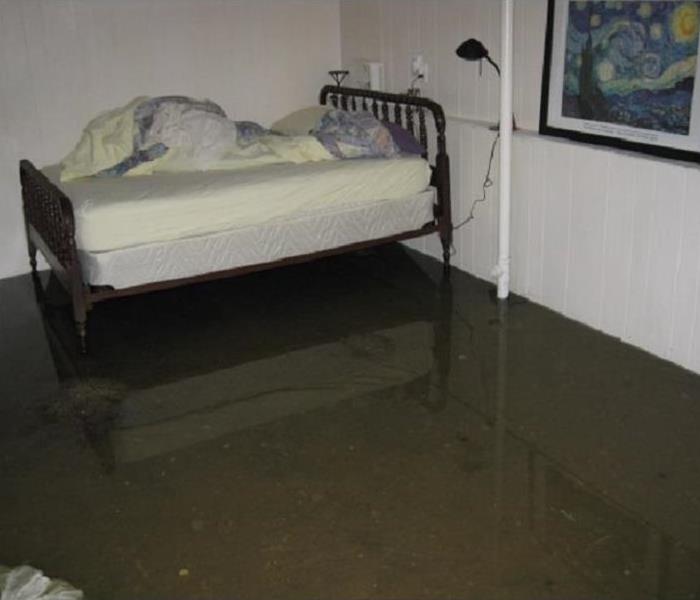 Flooded Basements can turn into serious water damage if not addressed quickly.
Flooded Basements can turn into serious water damage if not addressed quickly.
A basement can flood at any time, although flooding most often occurs during heavy rainfall. Basements are inherently prone to flooding because they are the lowest level of a building and are normally built partly or entirely below ground level. There are a number of reasons why your Grand Rapids basement could flood, including:
- A blocked or failed sewer lateral pipe
- Heavy rain causes surface water to pool around your home
- Foundation drainage failure
- Water supply-line break or hot-water tank failure
Customer Testimonial - Joyce G "Our basement flooded due to septic pump failure and SERVPRO of South and Northwest Grand Rapids responded to my call with-in 15 minutes with a team of Professionally Trained technicians. They handled all of our furniture and belongings with extreme care. It was a real blessing to have them in my home to relieve the stress of the situation and to have everything cleaned beyond my expectations."
Have Questions about Basement Flooding?
Call Today - 616-662-9700
If flood water is not handled quickly and properly, it can jeopardize your health and safety, and cause severe damage to your home’s structure. Remember, the longer you wait the worse the problem will get.
Here is the bottom line: a flooded basement can jeopardize your health, safety, and your home’s integrity. It’s worth making a call to SERVPRO of South and Northwest Grand Rapids and let our trained, professional crews handle the situation safely and correctly. We have earned the trust of hundreds of homeowners, business owners, and property professionals.
We are Flooded Basement Specialists:
- We are Available 24 hours/7 days per week
- We’re a Preferred Vendor to many National Insurance Companies
- We Bill The Insurance Directly – One Less Thing For You To Worry About
- Our Technicians are Highly-Trained in Water Restoration Techniques
- We use IICRC Restoration Standards
- Advanced Inspection and Extraction Equipment
Water Damage Recovery Tips For Your Hardwood Floors
10/22/2019 (Permalink)
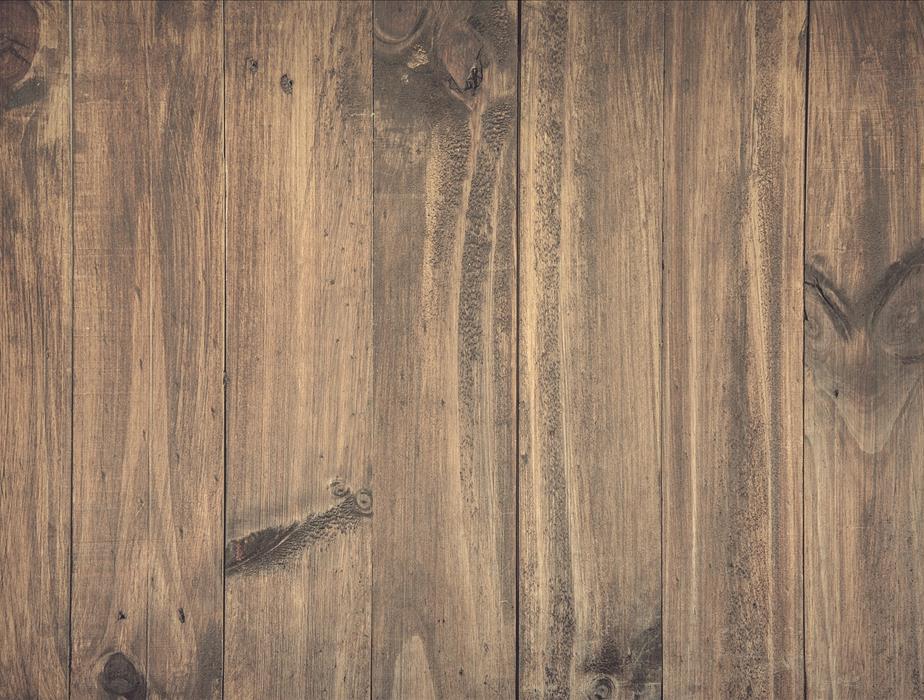 If water damage affects your hardwood floor, don't hesitate to call SERVPRO of South and North West Grand Rapids!
If water damage affects your hardwood floor, don't hesitate to call SERVPRO of South and North West Grand Rapids!
Floods are devastating to many areas of your home or business, and your wood floors will be seriously at risk. When water sits on top of hardwood, the wood absorbs the water through its pores and will cause warping and discoloration, potentially causing permanent damage. If you have experienced water damage to your premises, we would like to share some water damage recovery tips with you that can help:
- Remove Water Fast. Remove all water as quickly as you can. The longer the water remains, the worse the damage will be. The first 24 hours are critical, but if you are able to remove the water and dry your hardwood floors completely, you may be able to save them. You will also be alleviating the possibility of a mold invasion, too.
- Sand/Refinish. You will most likely need to sand and refinish the wood. This repair can bring your floors back to pre-flood conditions, or at least as close as possible. The sanding and refinishing step will save you both the time and the money that would be involved in having your flooring removed and new flooring installed.
- Bring In Professionals. If you have experienced really serious water damage, perhaps from a tornado, hurricane, or severe flooding, your best choice is contacting a professional water damage restoration service. Choose experts in this area that have the personnel and equipment necessary to get your water damage taken care of as fast as possible. Make sure you call them immediately, since these companies will probably have a waitlist if your entire area has been affected by a weather-related disaster.
- Preventive Measures.
- Find the source of water and plug it up.
- Remove all wet items from the flooring. If you have carpeting on top of your hardwood floor, remove both the carpet and the padding immediately. This is an area where mold can quickly become a real issue. Remember that your restoration professionals can help you with carpet-cleaning after a water damage event, too.
- Use a household vacuum or a shop-vac to extract as much water as you can, and be sure to contact your professionals if the amount of water is really large.
- Disinfect. Prevent mold and preserve your hardwood floors by using a non-sudsy disinfectant, and then vacuum again to remove standing water.
- Drying. Use a dehumidifier or run your heater or air conditioner constantly to keep the air dry inside the affected room(s).
These are just a few steps that you can take yourself when your hardwood floors are affected by water. SERVPRO of Grand Rapids is always here to help you with repairs and renovations to your property when you are affected by water damage, no matter the size. We also handle fire damage, and we are mold remediation experts, too.
Preparing Your Grand Rapids Home For Fall
8/13/2019 (Permalink)
As summer comes to a close, it’s a good idea to think ahead to the colder months coming to our area. Getting your home ready for fall and winter’s colder temperatures and harsher weather conditions while it’s still warm and pleasant will make your life a lot easier and leave you with plenty of time to enjoy the coziness of your house during the holidays. Weather may be unpredictable during the fall here in Grand Rapids, but you won’t have to worry about it if you prepare your home for fall now! Here are some preparations to consider:
- Gutters. Remove dead leaves and debris from your gutters and drainpipes. This will prevent clogging during wetter weather. Drain all outdoor faucets ahead of freezing weather now, as well.
- Chimney and Fireplace. Clear out leftover ash and charred wood from the fireplace, and contact a professional to clean the chimney. Ask the chimney cleaning company to make sure your damper can be closed properly so that drafts of cold air won’t be coming into your home during fall and winter months.
- Heating System. Check your home’s heating vents to make sure they won’t be blocked by furniture, floor coverings, or curtains, and dust them as well. All filters should be changed, and now is a great time to have a professional come and make that annual system checkup.
- Air Conditioners. Unplug any removable window air conditioners, cleaning them thoroughly before putting them in storage.
- Drafts. Examine all your windows and doors for cracks. If you find any, have them sealed now so that you can stay warm and save energy this fall and winter. You’ll be saving both time and money here!
- Storm Windows. Removable screens should be taken down and cleaned, stored and replaced with storm windows.
- Water Heater. Drain the water heater and clean out any debris that may have settled in the tank.
If you need help with the job of preparing your home for fall, just call the professional team here at SERVPRO of South and North West Grand Rapids. We have the expertise and the equipment needed to get the job done right.
Preventing Flooding in Your Grand Rapids Office
5/21/2019 (Permalink)
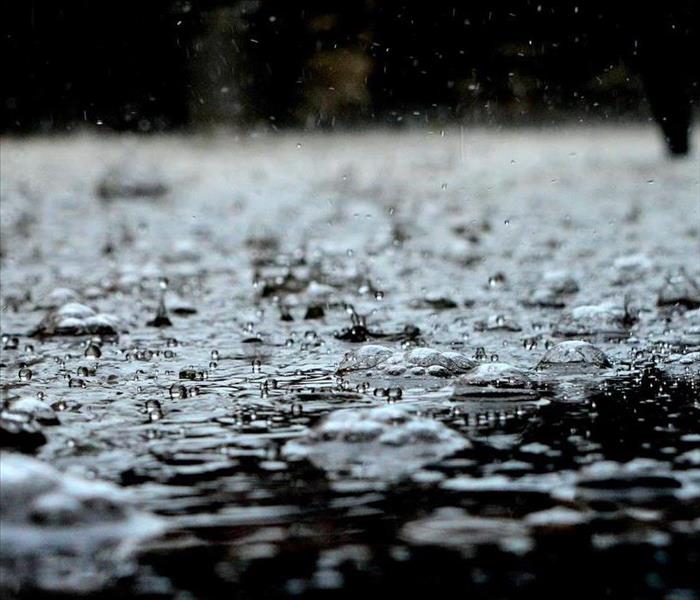 If you're dealing with flooding, give us a call! We can help you out.
If you're dealing with flooding, give us a call! We can help you out.
We all know what water damage to a business looks like after a flood or during heavy rainfall. Oftentimes, events such as these are unexpected, so it’s just good business to be prepared for this type of event.
Here are some tips to help you prevent flooding in your Grand Rapids office:
- INSPECTIONS. Take a good look around your place of business to ensure that you are prepared for wet weather. Check exterior doors to see if they fit as tightly as they should and that both doors and windows are properly weather-stripped. A small leak can easily turn into a small flood in your office space. Your office parking lot or driveway needs to have a well-planned drainage system so entering and exiting your building can be safe even during wet weather. Flooding in your parking areas can bring your business to a halt. If you know you’ll see a lot of run-off from the parking area, consider using sandbags. Low-lying buildings next to a parking lot full of water can end up flooding, and you will want to plan ahead to prevent that from happening.
- COMMUNICATE WITH PUBLIC SERVICES. Drainage areas that are maintained by the city or county should be monitored, especially during heavy rains. If these spots begin to overflow, contact your city representatives immediately. Keep them updated about the rivers and streams in your area, as well. If there is a problem developing, you can take steps to sandbag vulnerable areas around your office building.
- INTERIORS. Some flooding isn’t caused by weather, it’s caused by an equipment failure. Make sure your plumbing and appliances are regularly inspected and maintained so that you don’t walk into a mess on a Monday morning. It’s all about preparedness.
The team here at SERVPRO of South and North West Grand Rapids is ready to help in any way we can. We have the expertise to handle water and fire damage, and we specialize in mold remediation. If you have sustained water damage to your property, give us a call today at (616) 662-9700, or visit us on our website.
How to Prepare Your Grand Rapids Home for Spring
4/9/2019 (Permalink)
 Spring brings showers...which can bring water damage. Call us today to help out!
Spring brings showers...which can bring water damage. Call us today to help out!
There is often still some snow on the ground this time of year in Grand Rapids, but the obvious signs of springtime are around us, too. You can see buds on the trees and the daffodils are showing their faces. We know you are more than ready for warmer weather, but what about your home?
Here are a few things to think about when it comes to preparing your Grand Rapids home for Spring:
Rain Gutters. These should be first on your to-do list. They can be full of dead leaves, small branches, and even dirt from winter weather. Clean out all rain gutters right away so the spring showers don’t cause mold problems and water damage to interior walls, and make sure the downspouts are directing water the right way, as well. The winter weather here in Grand Rapids could have caused them to change position.
Roofing. Did your roof fare well during the winter? As the melting begins, keep an eye on it to see if any leaks have started over the past few weeks and months. Take a look at any vents to see if vegetation or mold has taken hold.
Filters. The filters in your HVAC unit will probably need to be changed at this point, and you will want to clean out ducts, vents, and the system itself. Ductwork can be hard to check, so keep in mind that the SERVPRO team at SERVPRO of South and North West Grand Rapids is always ready to come out and help.
Windows. Now is a good time to inspect windows for storm and water damage. Cracks, damaged weather stripping, improper fit: all these issues can cause problems down the road. Make arrangements to get your windows professionally cleaned and ready to enjoy the warmth and sunshine.
Foundations. Remove any remaining snow 3 to 5 feet away from your foundations and inspect them for cracks caused by winter weather conditions. These can be caulked and sealed as soon as you notice them.
Irrigation Systems. Check sprinkler systems and replace anything that has been affected by freezing conditions.
If you notice any really severe damage from winter storms during your inspections, don’t forget to take pictures for insurance purposes. If you need to make a claim of any kind, photos will come in handy.
You can rely on SERVPRO of South and North West Grand Rapids for all your repairs and clean-up needs. We specialize in water and storm damage, fire damage, and mold prevention. You can contact us by phone at (616) 662-9700, or visit us on our website.
Call the CLEANUP TEAM SERVPRO® of Southwest Grand Rapids, Faster to any size disaster
5/4/2018 (Permalink)
 We're here to help 24/7 for your water damage needs!
We're here to help 24/7 for your water damage needs!
There’s no such thing as a small disaster—especially when a small leak now could blossom into a big claim later. Unseen water can soak through walls, seep through carpet and pool on sub floors, causing major problems over time. You need help—fast. No matter what time of day or night, contact SERVPRO® of Southwest Grand Rapids at 616-662-9700 to begin emergency mitigation.
Emergency mitigation means that under normal circumstances, we will be on-site within four hours to begin drying your building and restoring contents. The faster the water is removed, the less chance of serious damage to your facility. Every SERVPRO® of Southwest Grand Rapids technician is trained and understands how to manage the drying process. By utilizing state-of-the-art equipment and the latest technology, your structure will be quickly and thoroughly dried, which helps prevent secondary water damages.
SERVPRO® of Southwest Grand Rapids will remove moisture and any contaminants by disinfecting and deodorizing to safely clean and dry your building and contents. Help ensure the value of your property by calling us at 616-662-9700.
Southwest Grand Rapids, understand water types to ensure proper clean up
5/3/2018 (Permalink)
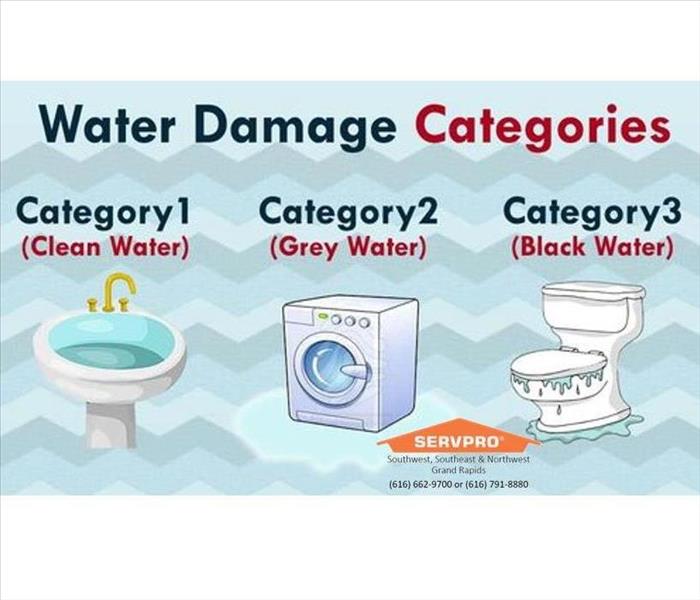 Different types of water loss determine how you should take personal precautions.
Different types of water loss determine how you should take personal precautions.
When your home or business suffers a water damage, understanding what type of water you are dealing with is critical to ensuring proper cleanup.
There are three types of water. Clean water is water from a broken pipe, or other water source; rainwater is also considered clean. The term gray water is used to classify slightly contaminated water. Clean water becomes gray water when it is left untreated allowing bacteria and other contaminants to begin growing, making the water hazardous. Black water is highly contaminate and filled with fungi, bacteria, chemicals and more. Black water is typically caused by sewage damage, flooding or any type of natural disaster. Black water should always be handled by trained professionals.
Consider taking the following precautions to help minimize damage or prevent further damage while waiting for help to arrive.
Damage from Clean Water
- Shut off the water source if possible or contact a qualified professional to do so.
- Turn off circuit breakers for wet areas of the building if access to the power distribution panel is safe from potential electrical shock. Do not enter rooms with standing water, as electrical shock hazards may exist.
- Remove as much excess water as possible by mopping and blotting. Wipe excess water from wood furniture after removing lamps and table top items.
- Remove and prop up wet upholstery cushions to allow more even drying.
- Move any paintings, art objects, computers, document sand other valuable items that may be sensitive to moisture to a safe place.
- Do not leave books, newspapers, magazines or other colored items on wet carpets or floors as they may cause staining.
- Do not use your household vacuum cleaner to remove water as there is potential for electrical shock or causing damage to the vacuum cleaner.
- Do not turn on ceiling fixtures if ceiling is wet; do not enter rooms where ceilings are sagging from retained water.
Damage from Contaminated Water
- Avoid all contact with sewage and items contaminated by sewage. Wash your hands thoroughly if you come in contact with contaminated items.
- Do not walk through contaminated areas, as you could spread damage to unaffected areas.
- Do not turn on the HVAC system if there is a possibility of spreading contaminated air.
- Discard any food and/or products for personal hygiene and cleanliness if exposed to the contaminated areas.
When you have a water damage, don’t leave your property to chance. Call SERVPRO® of Southwest Grand Rapids at 616-662-9700.
Southwest Grand Rapids it’s the water you don’t see that causes the damage!
5/1/2018 (Permalink)
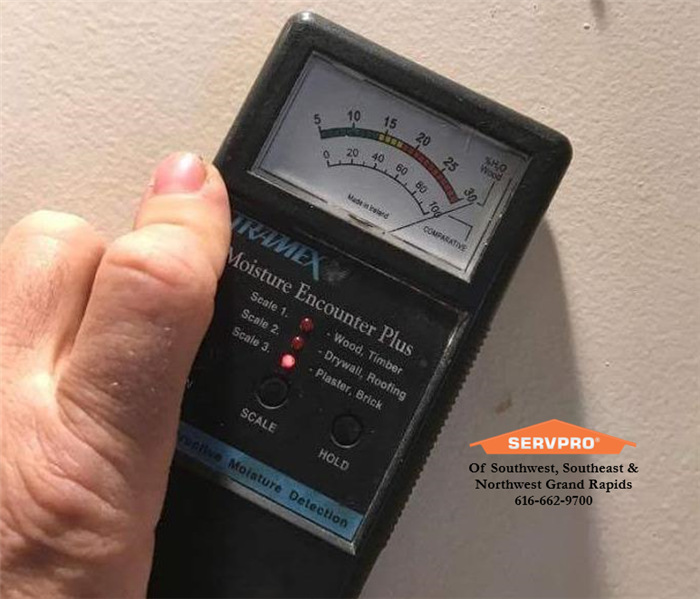 What's in your walls? Moisture in them can quickly lead to Mold.
What's in your walls? Moisture in them can quickly lead to Mold.
Even small water damages have the potential to cause serious structural and indoor air quality issues over time. The key to avoiding costly problems in the future is to handle every water damage as a threat to your property. SERVPRO® of Southwest Grand Rapids has the equipment, training and experience to find and dry unseen water before secondary damages occur. The proper equipment makes a measurable difference in reducing the damage expense during a fire or water loss. When time matters, technology and equipment must be counted on to perform.
SERVPRO® of Southwest Grand Rapids will answer your call with rapid action and a full arsenal of drying equipment. Here are a few of the tools used by SERVPRO® of Southwest Grand Rapids Professionals.
- Moisture Sensors are used to detect moisture in carpets, baseboards and walls.
- Moisture Meters are used to determine the actual moisture content of various materials. The moisture tester provides accurate readings, allowing our technicians to monitor the drying process.
- Thermohygrometers measure temperature and relative humidity.
When armed with this information, SERVPRO® of Southwest Grand Rapids can calculate and create an environment most conducive to drying. When facing a contaminated water loss, it is not only important to dry the structure, but the structure must also be disinfected and often deodorized.
- Ultra Low-Volume (ULV) Foggers will atomize liquid deodorizing agents, producing a fine mist that can easily penetrate the site where odor-causing residues may accumulate. This device can also be used to inject fungicides and disinfectants into wall cavities and other hard-to-reach areas.
- Thermal Foggers dispense solvent-based products by creating a dense fog. The fog consists of tiny particles of deodorant solution that attach to and neutralize odor-causing particles.
The bottom line? SERVPRO® of Southwest Grand Rapids has the training and equipment to help make it “Like it never even happened.” Contact us at 616-662-9700 today for 24-hour emergency service.
It only takes 1 to 2 inches of water to begin damage to your Southwest Grand Rapids property
4/26/2018 (Permalink)
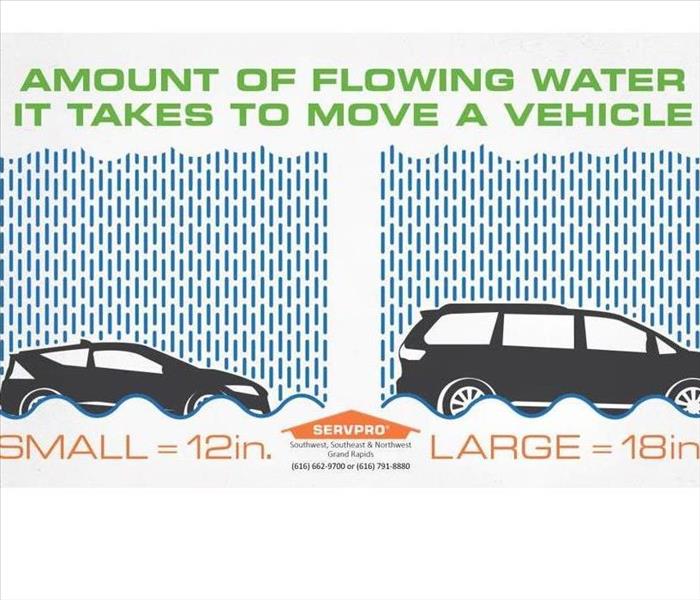 If water can move a car, imagine what it can do to your home!
If water can move a car, imagine what it can do to your home!
Image its 8:00 p.m. on a Sunday, and you walk into your home after a relaxing vacation expecting to switch on the lights, put the kids to bed then get some rest yourself.
The only problem? A water pipe burst over the weekend, dumping thousands of gallons of water over your hardwood kitchen floor, your carpeted living room and your cement utility room. You realize this problem is far beyond the reach of your shop vac. What do you do now?
When it is your home or business that is underwater, mitigation cannot wait. You need mitigation to begin immediately. If water damage strikes you or your neighbor give SERVPRO® of Southwest Grand Rapids a call at 616-662-9700 any time, any day.
The cost of water damages can increase exponentially with time. Wood Floors warp, dry wall soaks in moisture and mold develops in hard-to-reach areas of your home or business.
The benefit of rapid mitigation offer by SERVPRO® of Southwest Grand Rapids are two-fold: Your costs go down as potential hazards may be avoided, and your peace of mind goes through the roof.
If the unthinkable happens to your home or business, allow SERVPRO® of Southwest Grand Rapids to help quickly turn your “before” into a “happily ever after.”
We Specialize in Flooded Basement Cleanup and Restoration!
3/30/2018 (Permalink)
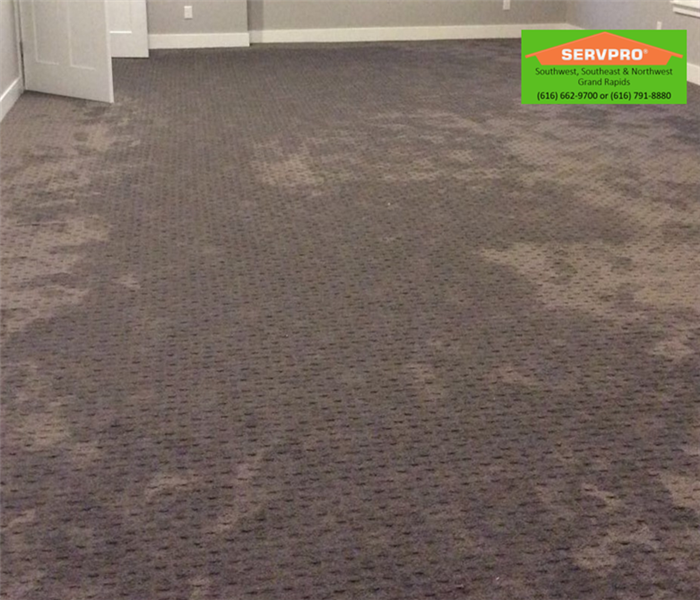 Frozen water line burst in the wall of this Southwest Grand Rapids home.
Frozen water line burst in the wall of this Southwest Grand Rapids home.
A basement can flood at any time, although flooding most often occurs during heavy rainfall. Basements are inherently prone to flooding because they are the lowest level of a building and are normally built partly or entirely below ground level. There are a number of reasons why your Grand Rapids basement could flood, including:
- A blocked or failed sewer lateral pipe
- Heavy rain causes surface water to pool around your home
- Foundation drainage failure
- Water supply-line break or hot-water tank failure
Customer Testimonial - Joyce G "Our basement flooded due to septic pump failure and SERVPRO of SW, SE, NW Grand Rapids responded to my call with-in 15 minutes with a team of Professionally Trained technicians. Their handled all of our furniture and belonging’s with extreme care. It was a real blessing to have them in my home to relieve the stress of the situation and to have all everything cleaned out beyond my expectations."
Have Questions about Basement Flooding?
Call Today - 616-662-9700
If flood water is not handled quickly and properly, it can jeopardize your health and safety, and cause severe damage to your home’s structure. Remember, the longer you wait, the worse the problem will get.
The bottom line: a flooded basement can jeopardize your health, safety, and your home’s integrity. It’s worth making a call to SERVPRO of Southwest Grand Rapids and let our trained, professional crews handle the situation safely and correctly. We have earned the trust of hundreds of homeowners, business owners, and property professionals.
We are Flooded Basement Specialists:
- We are Available 24 hours/7 days per week
- We’re a Preferred Vendor to many National Insurance Companies
- We Bill The Insurance Directly – One Less Thing For You To Worry About
- Our Technicians are Highly-Trained in Water Restoration Techniques
- We use s500 IICRC Restoration Standards
- Advanced Inspection and Extraction Equipment
Water damage prevention tips
3/5/2018 (Permalink)
 Decluttered and Organized spaces is a great way to protect your contents when water damage occurs at your home.
Decluttered and Organized spaces is a great way to protect your contents when water damage occurs at your home.
Water damage to your property is a very devastating experience. It gets into the tinniest of spaces and travels like a winding stream. That is because water has found the weak spot in any material and followed it. Have you ever had a sump pump fail or a busted water pipe? You unknowingly step in water and wonder where in the world is this coming from?
As you follow the water trail, you notice contents in your home are wet. It’s no big deal just the outside of the box is wet, Right? Keep following the water trail and now you know you have a bigger problem. Your entire floor is covered with water!
First things first – stop or turn off the water source, wither it be a water line or the sump pump. Turn off the main water line or just the affected portion to fix the pipe. Replace or fix the sump pump is that is the culprit. Either call a plumber or fix it yourself. Big thing is to stop the source of the leak to prevent more water damage.
Second call SERVPRO of Southwest Grand Rapids to extract the water and dry out your home.
But what about all your contents that got damaged? How can you protect your personal belongings from being ruined by water? Here are a few suggestions:
- Invest in Plastic totes with lids to store items instead of cardboard.
- Annual declutter clean. Take time each year to go through your items and use the Keep, Donate or Trash pile system. If it’s broke, trash it. If you have used in the last year and foresee usage in the next year keep it. If it doesn’t fit, haven’t used in the last year or more, donate it.
- Make sure you have the proper insurance coverage for your contents, in the event they do get damaged.
- Remember to winterize your pipes.
- Perform annual maintenance on your sump pump.
- Know where the main the water shut off valve to stop the water from pipes.
Being prepared to prevent damage is always a great measure to take, but do you know who to call when disaster strikes your property? Call SERVPRO® of Southwest Grand Rapids at 616-662-9700, we’re here to help!
Southwest Grand Rapids it’s the water you don’t see that causes the damage!
5/1/2017 (Permalink)
Even small water damages have the potential to cause serious structural and indoor air quality issues over time. The key to avoiding costly problems in the future is to handle every water damage as a threat to your property. SERVPRO of Southwest Grand Rapids has the equipment, training and experience to find and dry unseen water before secondary damages occur. The proper equipment makes a measurable difference in reducing the damage expense during a fire or water loss. When time matters, technology and equipment must be counted on to perform.
SERVPRO of Southwest Grand Rapids will answer your call with rapid action and a full arsenal of drying equipment. Here are a few of the tools used by SERVPRO of Southwest Grand Rapids Professionals.
- Moisture Sensors are used to detect moisture in carpets, baseboards and walls.
- Moisture Meters are used to determine the actual moisture content of various materials. The moisture tester provides accurate readings, allowing our technicians to monitor the drying process.
- Thermohygrometers measure temperature and relative humidity.
When armed with this information, SERVPRO of Southwest Grand Rapids can calculate and create an environment most condusive to drying. When facing a contaminated water loss, it is not only important to dry the structure, but the structure must also be disinfected and often deodorized.
- Ultra Low-Volume (ULV) Foggers will atomize liquid deodorizing agents, producing a fine mist that can easily penetrate the site where odor-causing residues may accumulate. This device can also be used to inject fungicides and disinfectants into wall cavities and other hard-to-reach areas.
- Thermal Foggers dispense solvent-based products by creating a dense fog. The fog consists of tiny particles of deodorant solution that attach to and neutralize odor-causing particles.
The bottom line? SERVPRO of Southwest Grand Rapids has the training and equipment to help make it “Like it never even happened.” Contact us at 616-662-9700 today for 24-hour emergency service.
Call the CLEANUP TEAM SERVPRO of Southwest Grand Rapids, Faster to any size disaster
5/1/2017 (Permalink)
There’s no such thing as a small disaster—especially when a small leak now could blossom into a big claim later. Unseen water can soak through walls, seep through carpet and pool on sub floors, causing major problems over time. You need help—fast. No matter what time of day or night, contact SERVPRO of Southwest Grand Rapids at 616-662-9700 to begin emergency mitigation.
Emergency mitigation means that under normal circumstances, we will be on-site within four hours to begin drying your building and restoring contents. The faster the water is removed, the less chance of serious damage to your facility. Every SERVPRO of Southwest Grand Rapids technician is trained and understands how to manage the drying process. By utilizing state-of-the-art equipment and the latest technology, your structure will be quickly and thoroughly dried, which helps prevent secondary water damages.
SERVPRO of Southwest Grand Rapids will remove moisture and any contaminants by disinfecting and deodorizing to safely clean and dry your building and contents. Help ensure the value of your property by calling us at 616-662-9700.
It only takes 1 to 2 inches of water to begin damage to your Southwest Grand Rapids property
5/1/2017 (Permalink)
Image it’s 8:00 p.m. on a Sunday, and you walk into your home after a relaxing vacation expecting to switch on the lights, put the kids to bed then get some rest yourself.
The only problem? A water pipe burst over the weekend, dumping thousands of gallons of water over your hardwood kitchen floor, your carpeted living room and your cement utility room. You realize this problem is far beyond the reach of your shop vac. What do you do now?
When it is your home or business that is underwater, mitigation cannot wait. You need mitigation to begin immediately. If water damage strikes you or your neighbor give SERVPRO of Southwest Grand Rapids a call at 616-662-9700 any time, any day.
The cost of water damages can increase exponentially with time. Wood Floors warp, dry wall soaks in moisture and mold develops in hard-to-reach areas of your home or business.
The benefit of rapid mitigation offer by SERVPRO of southwest Grand Rapids are two-fold: Your costs go down as potential hazards may be avoided, and your peace of mind goes through the roof.
If the unthinkable happens to your home or business, allow SERVPRO of Southwest Grand Rapids to help quickly turn your “before” into a “happily ever after.”
Southwest Grand Rapids understand water types to ensure proper clean up
5/1/2017 (Permalink)
When your home or business suffers a water damage, understanding what type of water you are dealing with is critical to ensuring proper cleanup.
There are three types of water. Clean water is water from a broken pipe, or other water source; rainwater is also considered clean. The term gray water is used to classify slightly contaminated water. Clean water becomes gray water when it is left untreated allowing bacteria and other contaminants to begin growing, making the water hazardous. Black water is highly contaminate and filled with fungi, bacteria, chemicals and more. Black water is typically caused by sewage damage, flooding or any type of natural disaster. Black water should always be handled by trained professionals.
Consider taking the following precautions to help minimize damage or prevent further damage while waiting for help to arrive.
Damage from Clean Water
- Shut off the water source if possible or contact a qualified professional to do so.
- Turn off circuit breakers for wet areas of the building if access to the power distribution panel is safe from potential electrical shock. Do not enter rooms with standing water, as electrical shock hazards may exist.
- Remove as much excess water as possible by mopping and blotting. Wipe excess water from wood furniture after removing lamps and table top items.
- Remove and prop up wet upholstery cushions to allow more even drying.
- Move any paintings, art objects, computers, document sand other valuable items that may be sensitive to moisture to a safe place.
- Do not leave books, newspapers, magazines or other colored items on wet carpets or floors as they may cause staining.
- Do not use your household vacuum cleaner to remove water as there is potential for electrical shock or causing damage to the vacuum cleaner.
- Do not turn on ceiling fixtures if ceiling is wet; do not enter rooms where ceilings are sagging from retained water.
Damage from Contaminated Water
- Avoid all contact with sewage and items contaminated by sewage. Wash your hands thoroughly if you come in contact with contaminated items.
- Do not walk through contaminated areas, as you could spread damage to unaffected areas.
- Do not turn on the HVAC system if there is a possibility of spreading contaminated air.
- Discard any food and/or products for personal hygiene and cleanliness if exposed to the contaminated areas.
When you have a water damage, don’t leave your property to chance. Call SERVPRO of Southwest Grand Rapids at 616-662-9700.
Southwest Grand Rapids 24 Hour Emergency Water Damage Service
4/10/2017 (Permalink)
SERVPRO of Southwest Grand Rapids is available 24 hours a day for water emergencies, large or small. When you are dealing with water damage, immediate action is crucial. A delay of just a few hours can greatly increase the severity of the water damage.
We Answer the Phone Ready to Help Call Today – 616-227-9700
We understand that when you call us, you may be feeling confused, stressed, and vulnerable. You need an expert to guide you through this crisis. SERVPRO of Southwest Grand Rapids has the specific water damage training and experience to help you through this tough time. We specialize in water damage restoration—in fact, it's the cornerstone of our business.
What to Expect
When you call, we will ask several questions regarding your water damage emergency. These questions will help us determine what equipment and resources to bring, including how many trained SERVPRO Professionals may be needed.
Our SERVPRO Representative will ask several questions:
- Your name and contact information
- Your insurance information (if applicable)
- The street address of the water-damaged home or business
- When did the flooding or water damage occur?
- What caused the water damage (if known)?
- Is there electricity available (on-site)?
About SERVPRO of Southwest Grand Rapids
SERVPRO of Southwest Grand Rapids specializes in the cleanup and restoration of residential and commercial property after a fire, smoke or water damage event. Our staff is highly trained in property damage restoration. From initial and ongoing training at SERVPRO’s corporate training facility to regular IICRC-industry certification, rest assured our staff is equipped with the knowledge to restore your property.
http://www.SERVPROsouthwestgrandrapids.com/employee-photos
Certifications
- UFT - Upholstery & Fabric Cleaning Technician
- SRT - Fire & Smoke Damage Restoration Technician
- IICRC Certified Firm
- HST - Health and safety Technician
- WRT - Water Damage Restoration Technician
- CMR - Council-certified Microbial Remediator
- CCT - Carpet Cleaning Technician
- ECTP - Employee Certification Training Program
We Specialize in Flooded Basement Cleanup and Restoration!
3/14/2017 (Permalink)
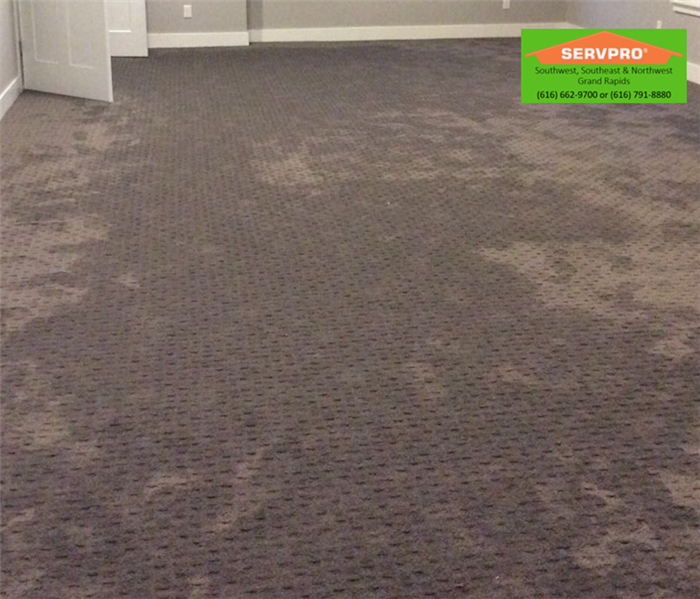 Frozen water line burst in the wall of this Southwest Grand Rapids home.
Frozen water line burst in the wall of this Southwest Grand Rapids home.
A basement can flood at any time, although flooding most often occurs during heavy rainfall. Basements are inherently prone to flooding because they are the lowest level of a building and are normally built partly or entirely below ground level. There are a number of reasons why your Grand Rapids basement could flood, including:
- A blocked or failed sewer lateral pipe
- Heavy rain causes surface water to pool around your home
- Foundation drainage failure
- Water supply-line break or hot-water tank failure
Customer Testimonial - Joyce G "Our basement flooded due to septic pump failure and SERVPRO of SW, SE, NW Grand Rapids responded to my call with-in 15 minutes with a team of Professionally Trained technicians. Their handled all of our furniture and belonging’s with extreme care. It was a real blessing to have them in my home to relieve the stress of the situation and to have all everything cleaned out beyond my expectations."
Have Questions about Basement Flooding?
Call Today - 616-662-9700
If flood water is not handled quickly and properly, it can jeopardize your health and safety, and cause severe damage to your home’s structure. Remember, the longer you wait, the worse the problem will get.
The bottom line: a flooded basement can jeopardize your health, safety, and your home’s integrity. It’s worth making a call to SERVPRO of Southwest Grand Rapids and let our trained, professional crews handle the situation safely and correctly. We have earned the trust of hundreds of homeowners, business owners, and property professionals.
We are Flooded Basement Specialists:
- We are Available 24 hours/7 days per week
- We’re a Preferred Vendor to many National Insurance Companies
- We Bill The Insurance Directly – One Less Thing For You To Worry About
- Our Technicians are Highly-Trained in Water Restoration Techniques
- We use s500 IICRC Restoration Standards
- Advanced Inspection and Extraction Equipment




 24/7 Emergency Service
24/7 Emergency Service
